The island of Hispaniola is home to a diverse array of bird species. Located in the Caribbean, with its unique geography and climate, Hispaniola boasts a vast range of habitats, from lush rainforests to arid deserts, making it a perfect spot for birdwatching enthusiasts.
There are currently over 300 species of birds on the island, including many endemic species that cannot be found anywhere else in the world.
The birds of Hispaniola have a rich history, with many species having played a crucial role in the island’s culture, symbolism, and mythology.
In this article, we will explore the various birds that call Hispaniola home and learn more about their significance and importance.
1. American Golden Plover
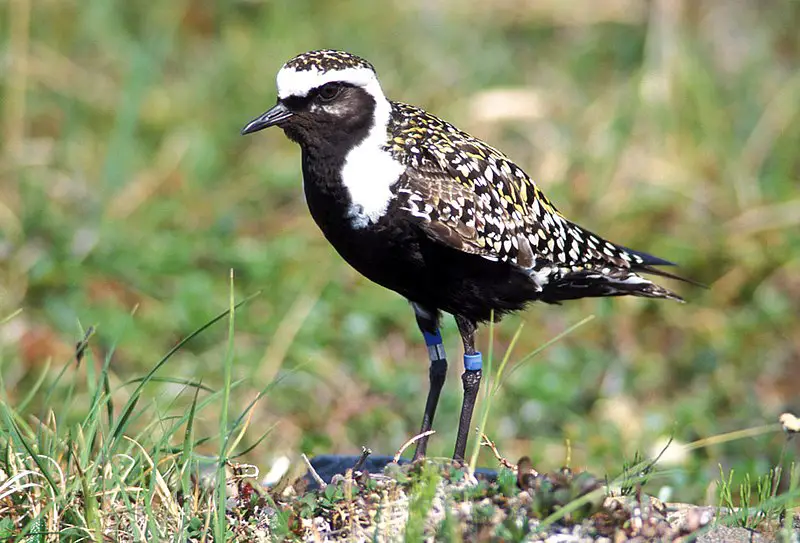
The American golden plover (Pluvialis dominica) is a medium-sized bird, part of the genus Pluvialis which translates to “relating to rain”.
It was named after Santo Domingo in the West Indies and believed that when they flocked, it predicted an upcoming rainfall.
Their nests are lined with spores picked up from their habitat – this also helps protect eggs against predators or parasites.
The birds have distinctive yellow and black plumage, allowing them to stand out amongst other species and making them easier for predators to spot.
They can fly great distances during migration season and inhabit open grasslands as well as arctic tundra regions all over North America throughout different times of year.
Scientific classification:
| Kingdom | Animalia |
| Phylum | Chordata |
| Class | Aves |
| Order | Charadriiformes |
| Family | Charadriidae |
| Genus | Pluvialis |
| Species | P. dominica |
Also Featured In: Most Popular Bird Species in North America, Tundra Birds
2. Tanagers
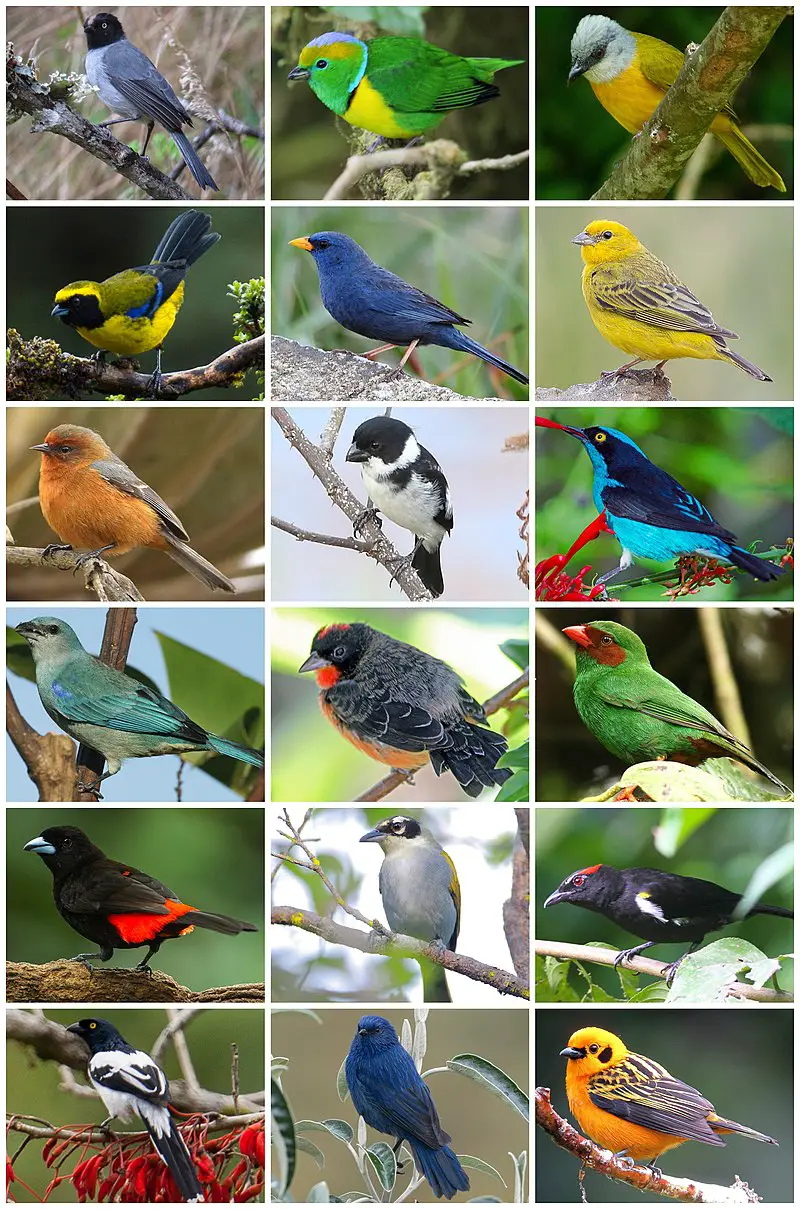
The Tanagers are a beautiful and diverse family of birds native to the Neotropical region. They boast an impressive array of colors, including blues, greens, yellows, and reds.
The most common type is the fruit-eating tanager which can be found in tropical forests across Latin America. With nearly 240 species worldwide, they represent almost 4% of all avian species.
These vibrant birds have adapted well to their environment due to their strong bills used for cracking open hard fruits as well as sharp claws for gripping branches while feeding or perching.
As with many other bird families, there is natural variation among populations making each one unique in its own way; something that makes them even more special.
Scientific classification:
| Kingdom | Animalia |
| Phylum | Chordata |
| Class | Aves |
| Order | Passeriformes |
| Superfamily | Emberizoidea |
| Family | Thraupidae Cabanis, 1847 |
Also Featured In: Beautiful Brazilian Birds, Blue Birds You’ll Found around Us
3. Double-Striped Thick-Knee
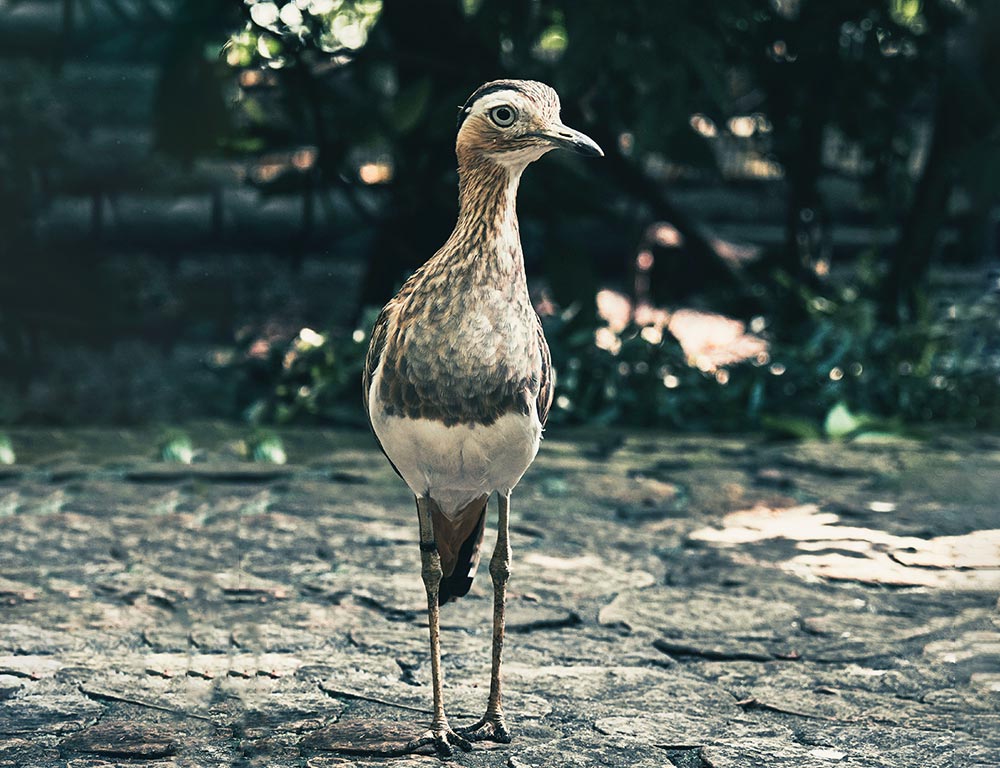
The double-striped thick-knee is a species of stone curlew, belonging to the family Burhinidae. It has long legs with prominent joints and two stripes on its head pattern that give it its name ‘bistriatus’.
This bird was first described in 1829 by Johann Georg Wagler from a specimen found in Mexico.
Its plumage varies between shades of grey and brown depending on the season, allowing for camouflage when perching or nesting amongst rocks or shrubs.
Double-striped thick knees are usually seen alone or in pairs but during breeding season they may gather together into small flocks.
They feed mainly on insects such as locusts, crickets, and grasshoppers which they catch using their strong beak after running around like chickens.
Scientific classification:
| Kingdom | Animalia |
| Phylum | Chordata |
| Class | Aves |
| Order | Charadriiformes |
| Family | Burhinidae |
| Genus | Burhinus |
| Species | B. bistriatus |
Also Featured In: Birds of Venezuela,
4. Hispaniolan Trogon
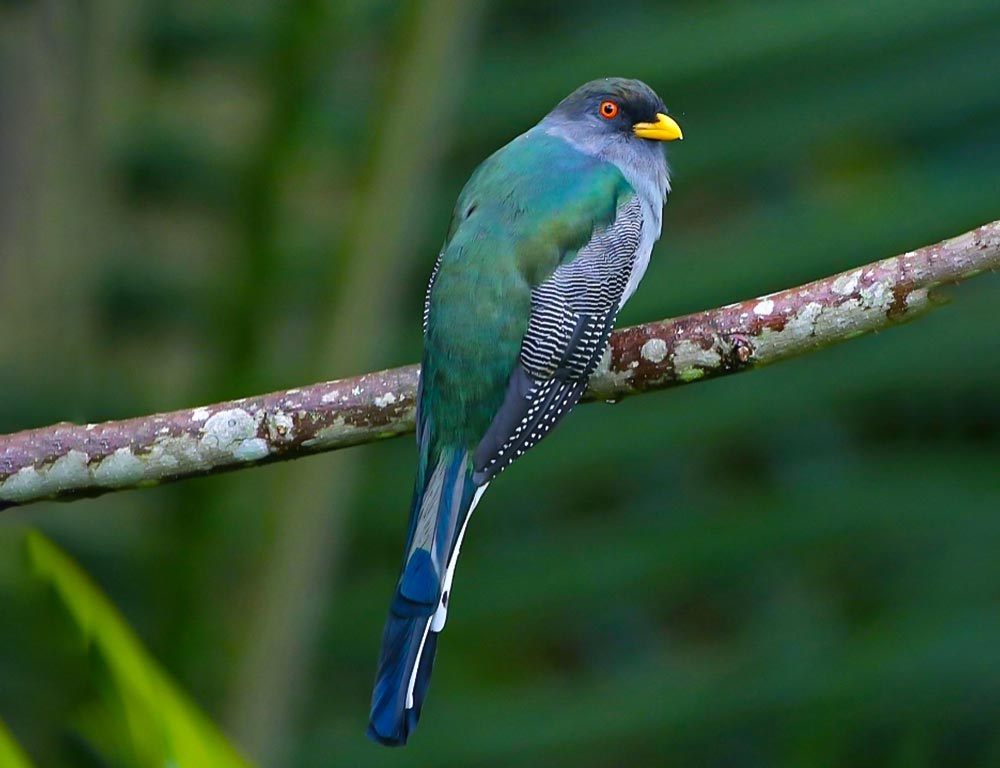
The Hispaniolan trogon is a stunning bird endemic to Haiti and the Dominican Republic in the Caribbean. It has brilliant colors, most notably its rose-colored back, deep blue face, bright yellow belly, and red tail feathers.
As one of only two species of trogons found in the Caribbean region, it is fittingly recognized as the national bird of Haiti.
Its distinct features include long graduated tails, small feet, and short thick bills which adds to its beauty.
The feeding habits are mainly on fruits like figs but also insects such as beetles and moths.
They build nests in hollow tree cavities or holes made by woodpeckers making them quite secretive birds that can be hard to spot within dense forests they inhabit with relative ease due to their agility flying between trees at high speeds.
Scientific classification:
| Kingdom | Animalia |
| Phylum | Chordata |
| Class | Aves |
| Order | Trogoniformes |
| Family | Trogonidae |
| Genus | Priotelus |
| Species | P. roseigaster |
Also Featured In: Birds of Haiti,
5. Hispaniolan Parakeet
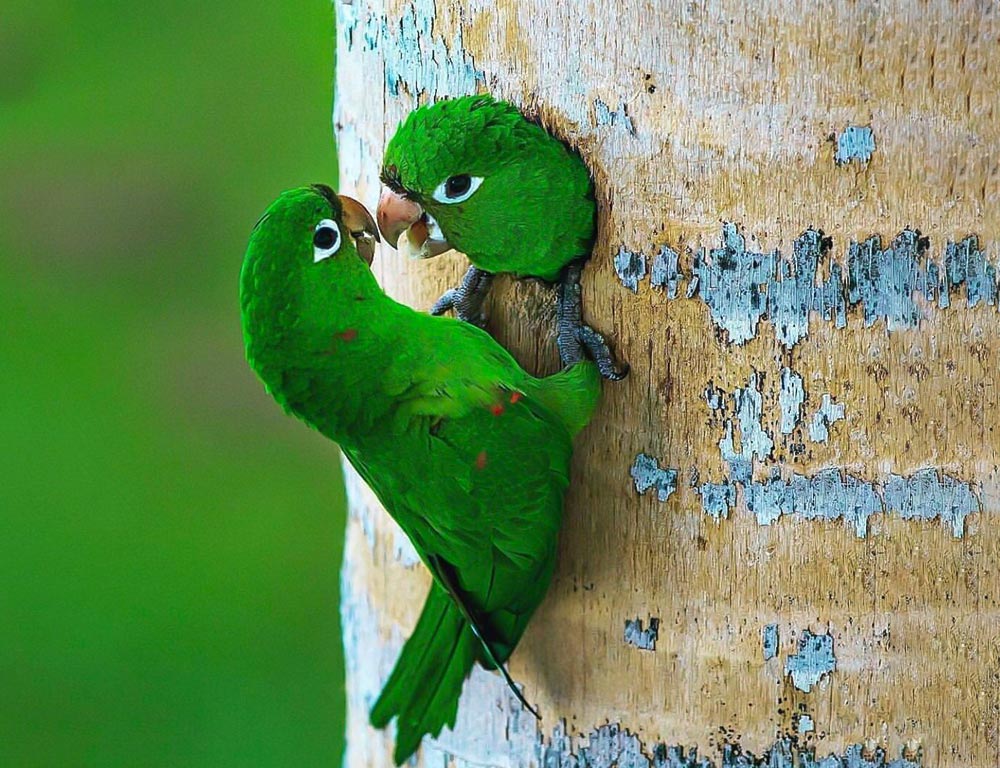
The Hispaniolan parakeet is a species of parrot endemic to the island of Hispaniola. It has green feathers, with yellow patches around its face and wings.
These birds are social creatures that form large flocks in open areas such as pastures or agricultural fields when foraging for food.
They feed mainly on fruits, nuts, and insects but will also take advantage of bird seed from backyard feeding stations.
Feral populations have been spotted in Guadeloupe, Puerto Rico, and even Miami – where they sometimes associate with canary-winged parakeets.
Despite their popularity among pet owners due to their intelligence and playfulness, these birds remain an endangered species due to habitat destruction caused by deforestation and hunting activities.
Scientific classification:
| Kingdom | Animalia |
| Phylum | Chordata |
| Class | Aves |
| Order | Psittaciformes |
| Family | Psittacidae |
| Genus | Psittacara |
| Species | P. chloropterus |
6. Hispaniolan Spindalis
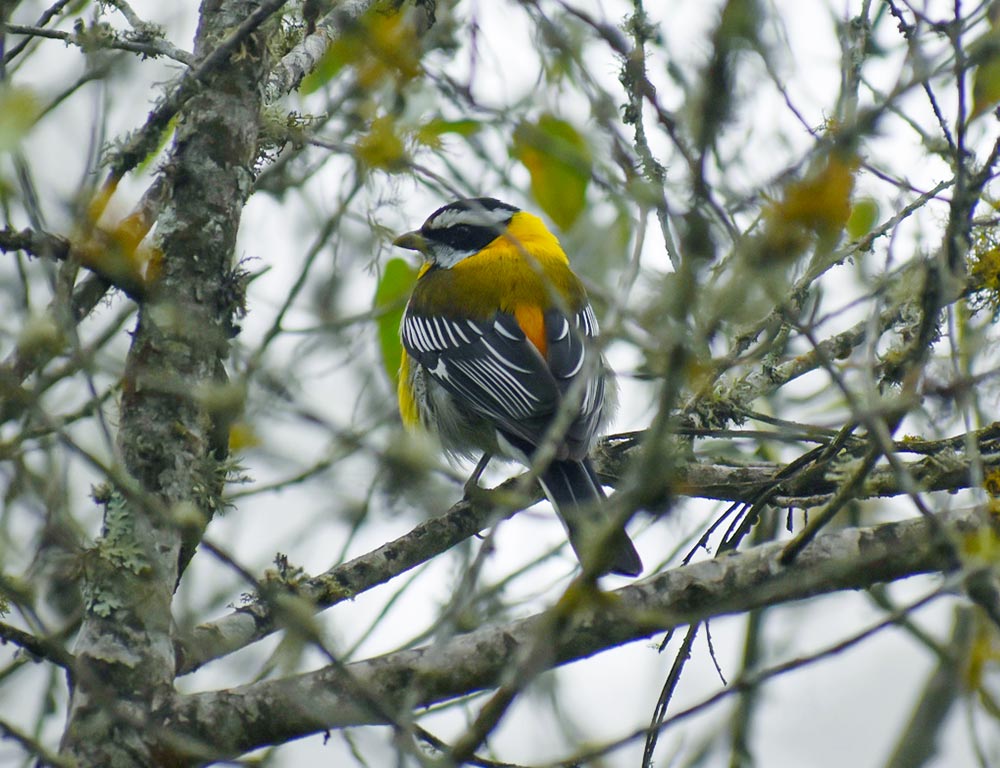
The Hispaniolan spindle is a vibrant and colorful bird found only in the Caribbean island of Hispaniola. It’s one of four species in the Spindalidae family and was historically known as stripe-headed tanager.
Its plumage consists of bright yellow, red, black, white, gray, and brown feathers that give it an attractive appearance. The wings are short but broad which helps them to fly fast from tree to tree looking for food like insects or fruits.
They can also be spotted near rivers searching for small fish or other aquatic invertebrates.
This amazing bird is quite social so you may find several individuals congregating together often forming pairs during breeding season when they build their nest on trees among branches close to trunks where they lay two eggs at once before incubation lasts about 13 days until hatching occurs around mid-April through May period each year.
Scientific classification:
| Kingdom | Animalia |
| Phylum | Chordata |
| Class | Aves |
| Order | Passeriformes |
| Family | Spindalidae |
| Genus | Spindalis |
| Species | S. dominicensis |
7. Hispaniolan Oriole
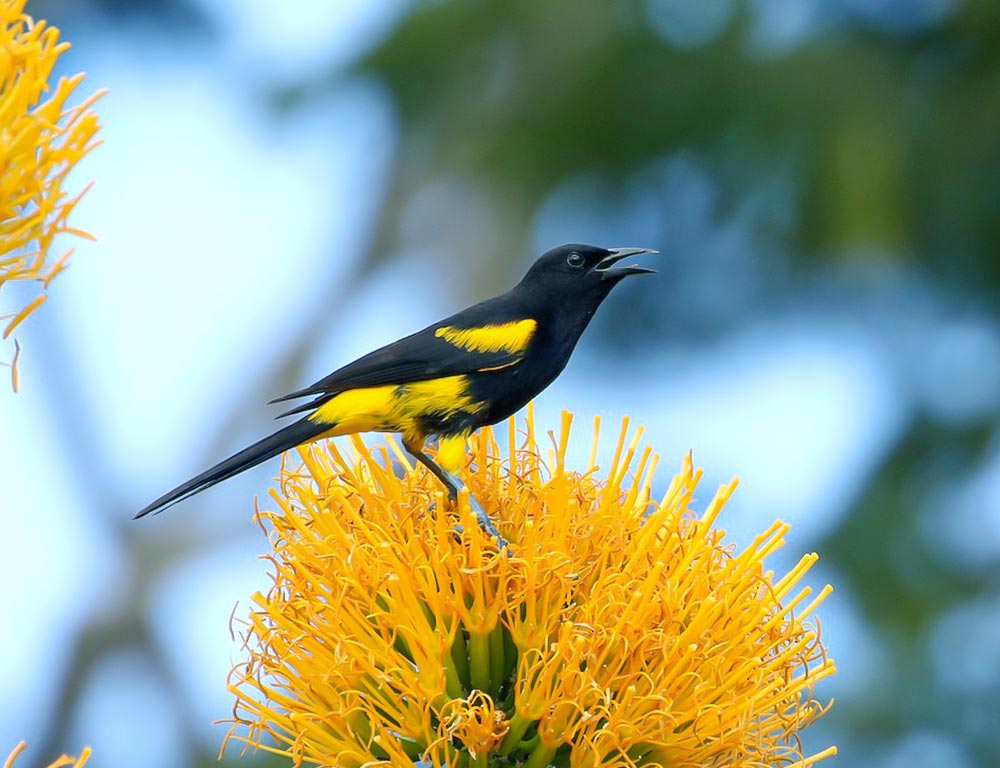
The Hispaniolan oriole is a beautiful bird found only on the Caribbean island of Hispaniola. Its scientific name, Icterus dominicensis, reflects its endemic existence in this region and it belongs to the family Icteridae.
The French zoologist Mathurin Jacques Brisson was one of the first people to document this species in 1760 when he collected a specimen from Saint-Domingue (now Haiti).
Today we can find these birds foraging among trees or perched atop branches singing their cheerful songs with yellow bodies, wings, and tails contrasted against black heads and backs – making them quite striking.
They mainly feed on insects but also enjoy fruits like mulberries as part of their diet. All in all, they are an important part of local ecosystems
Where they live so let’s hope that future generations will be able to appreciate them just as much as today’s observers do.
Scientific classification:
| Kingdom | Animalia |
| Phylum | Chordata |
| Class | Aves |
| Order | Passeriformes |
| Family | Icteridae |
| Genus | Icterus |
| Species | I. dominicensis |
8. Eastern Chat-Tanager
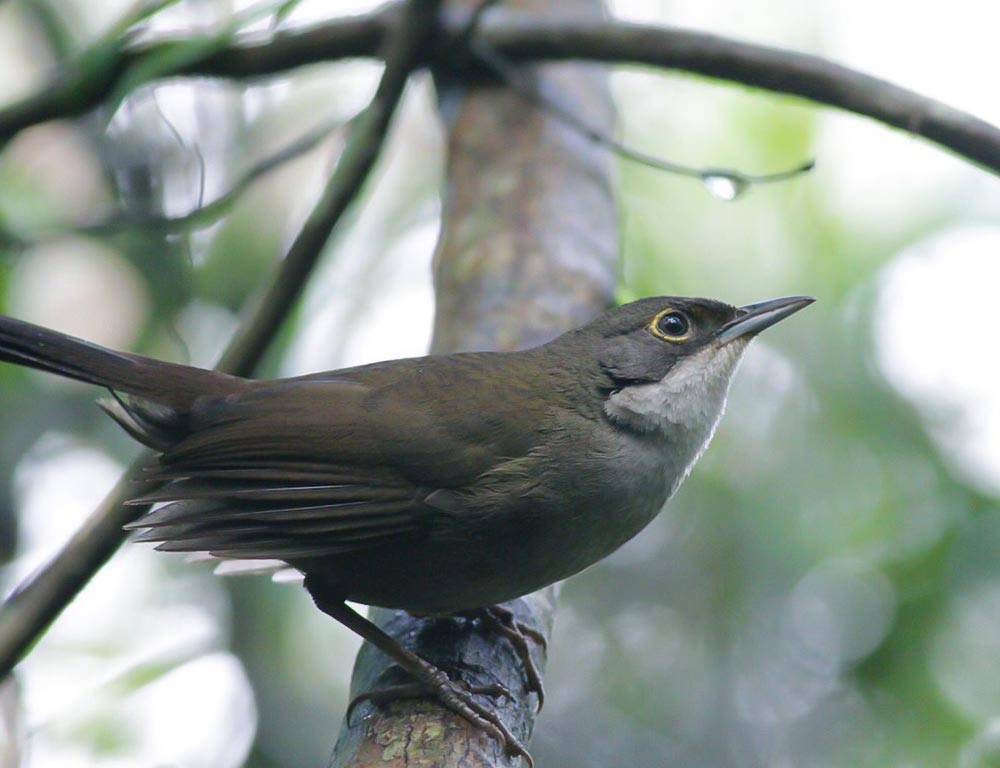
This small passerine has grey wings, blue upperparts, and white underparts on its body which makes it distinctive among other birds found in this area of the world.
The diet consists mostly of fruits as well as insects that they can find while foraging through trees or shrubs near their habitats located mainly at higher elevations on both sides of islands forming the Hispaniola region.
Conservation efforts are needed if we want these beautiful creatures to stay around us for many more years.
Scientific classification:
| Kingdom | Animalia |
| Phylum | Chordata |
| Class | Aves |
| Order | Passeriformes |
| Family | Calyptophilidae |
| Genus | Calyptophilus |
| Species | C. frugivorus |
9. Ashy-Faced Owl
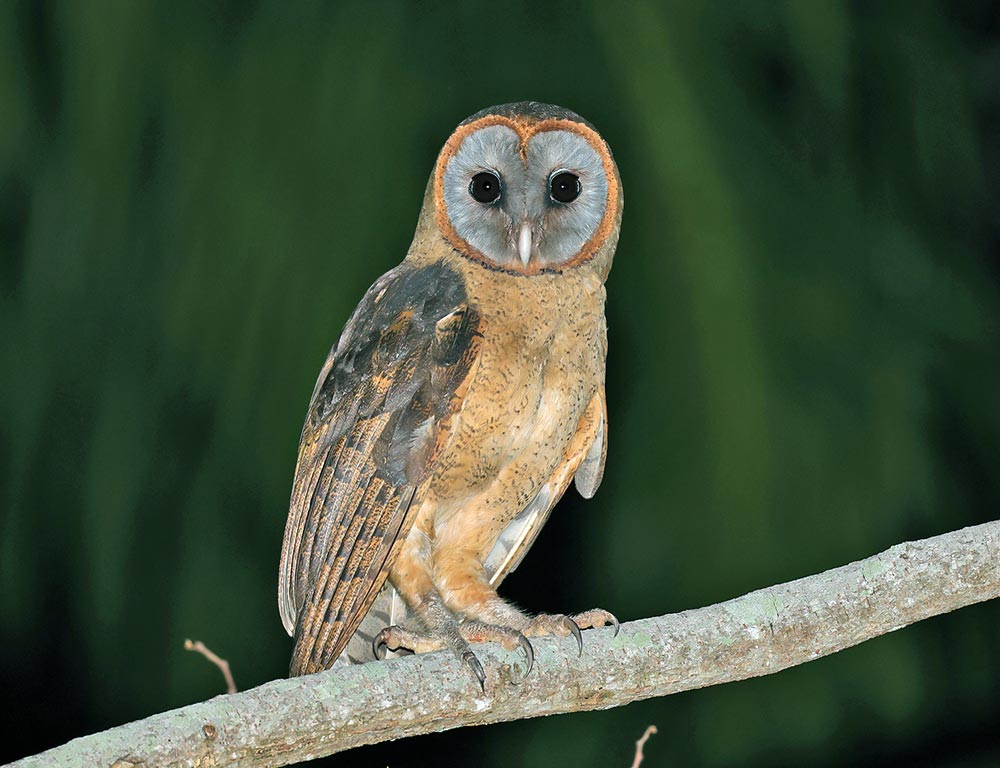
The Ashy-faced Owl is a species of owl found only on the Caribbean island of Hispaniola, split between Haiti and the Dominican Republic.
It has an ash-grey face with white eyebrows above its yellow eyes, while its wings and tail are barred black and brown.
This bird prefers subtropical or tropical dry shrubland habitats as well as high-altitude shrublands that have been heavily deforested.
Its diet consists mainly of small mammals such as mice and rats which it hunts at night by flying silently through open areas near their burrows.
The population of this species in recent years has decreased due to habitat destruction caused by human activities like logging, mining, agriculture expansion, etc, making them vulnerable to extinction unless urgent conservation measures are taken soon.
Scientific classification:
| Kingdom | Animalia |
| Phylum | Chordata |
| Class | Aves |
| Order | Strigiformes |
| Family | Tytonidae |
| Genus | Tyto |
| Species | T. glaucops |
10. Western Chat-Tanager
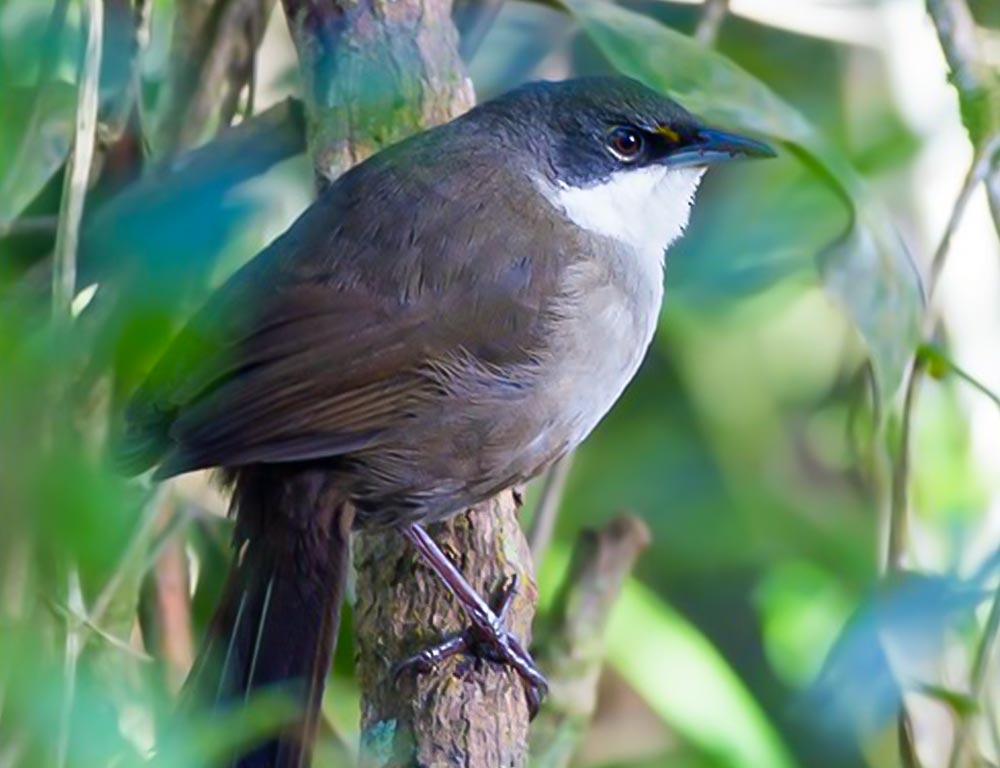
The Western chat-tanager is a beautiful, vulnerable passerine bird belonging to the family Calyptophilidae. Endemic to Hispaniola island shared by the Dominican Republic and Haiti, it was once considered as a subspecies of Eastern chat-tanager.
The male has a greyish head with whitish supercilium while its back and wings are olive green in color. Its breast is yellow-orange fading in an ochre tone towards the belly region whereas the throat area is white.
The female on the other hand exhibits browner upper parts than males and their underparts too appear duller compared to them.
Though similar-looking species occur sympatrically, vocalizations can be used for distinguishing between both members of this genus effectively due to differences observed in range frequency or tonal quality among them.
Thus western chat tanagers have been able to influence conservation efforts being made to save these birds from extinction by easily identifying them without any confusion.
Scientific classification:
| Kingdom | Animalia |
| Phylum | Chordata |
| Class | Aves |
| Order | Passeriformes |
| Family | Calyptophilidae |
| Genus | Calyptophilus |
| Species | C. tertius |
11. Northern Potoo
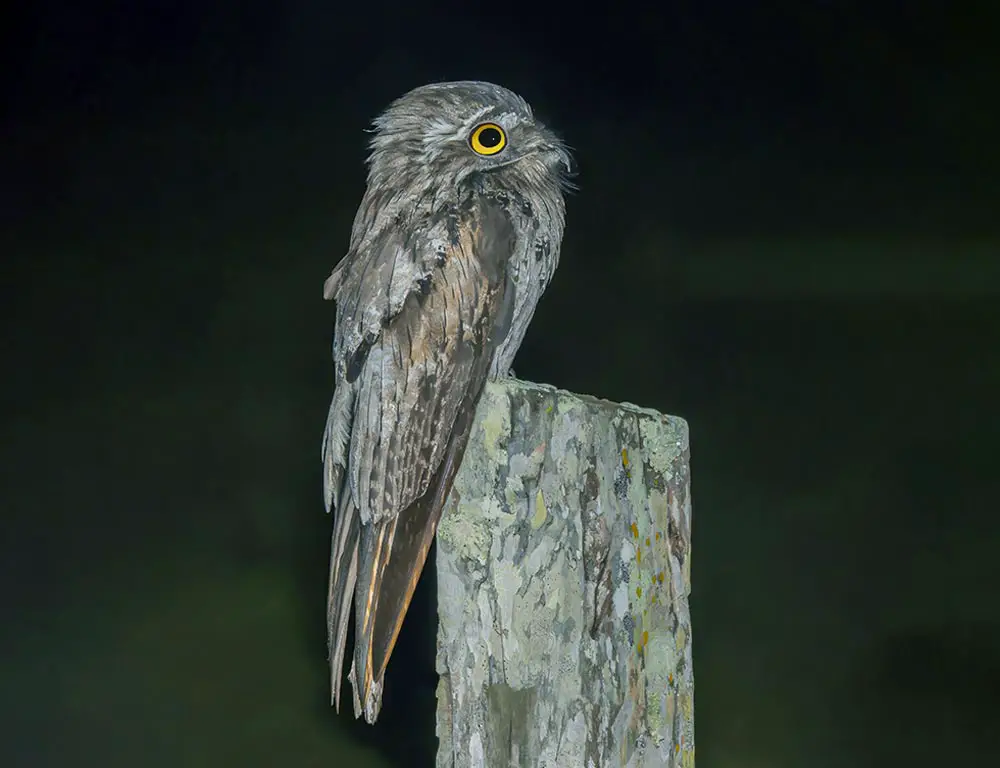
The Northern Potoo is a nocturnal bird belonging to the Nyctibiidae family. It inhabits Mexico, Central America, and some of the Caribbean Islands such as Jamaica and Hispaniola where it can be found in tropical dry forests.
It was formerly classified as a subspecies of Common Potoo but due to differences in vocalizations, they are now considered separate species.
This interesting bird has an almost comical appearance with its large head, long bill, short neck, and disproportionately long legs that give it an awkward gait when walking on land.
Its plumage is mottled grey-brown which helps camouflage itself during the day while perched motionless on tree branches looking for prey at night.
The Northern Potoos call consists mostly of whistles ending with trills making them quite easy to identify within their range area.
Scientific classification:
| Kingdom | Animalia |
| Phylum | Chordata |
| Class | Aves |
| Order | Nyctibiiformes |
| Family | Nyctibiidae |
| Genus | Nyctibius |
| Species | N. jamaicensis |
12. Antillean Siskin
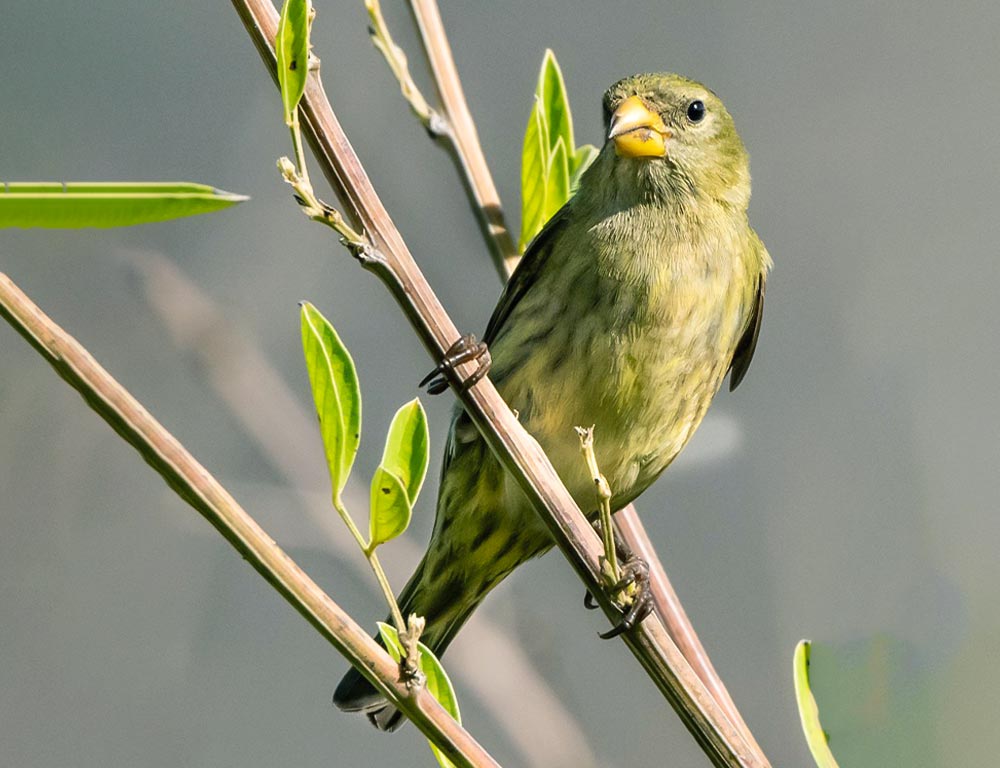
The Antillean siskin is a small, colorful finch native to Hispaniola. It has bright yellow plumage on its head and body, contrasting with a black bib and wings.
This species can only be found in the Caribbean region – namely Haiti and the Dominican Republic – where it inhabits subtropical or tropical moist montane forests as well as degraded former forest areas.
The siskin is thought to be the oldest extant North American bird species still alive today. Its diet consists of seeds, fruits, buds, and insects which are gleaned from leaves or taken directly off trees while flying between branches.
Conservation efforts must remain focused on preserving this beautiful avian’s natural habitat so that future generations may admire its unique characteristics for years to come.
Scientific classification:
| Kingdom | Animalia |
| Phylum | Chordata |
| Class | Aves |
| Order | Passeriformes |
| Family | Fringillidae |
| Subfamily | Carduelinae |
| Genus | Spinus |
| Species | S. dominicensis |
13. Hispaniolan Mango
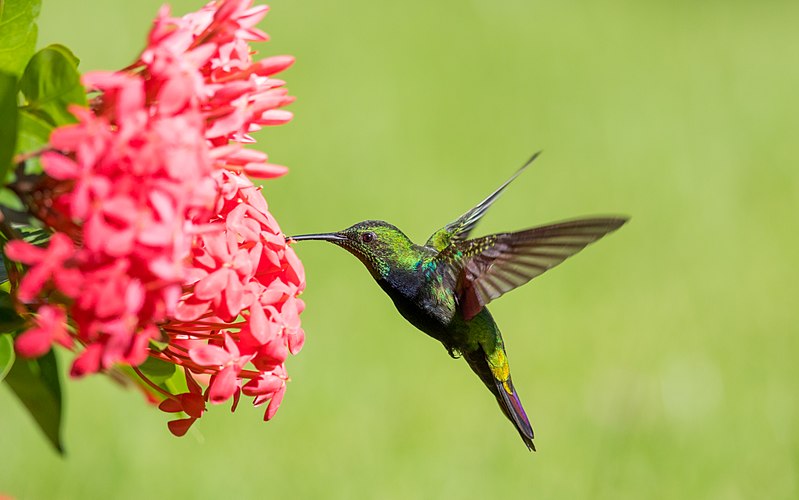
The Hispaniolan mango bird is a species of hummingbird native to the Caribbean island of Hispaniola. It was first described by Swedish naturalist Carl Linnaeus in 1766, under the binomial name Trochilus dominicus.
This vibrant and colorful bird has olive-green upperparts with dusky wings and tail, while its head is white with a black mask on either side of its face.
Its belly is also bright yellow or golden. The male can be identified easily as it has two elongated central feathers protruding from his crown that are tipped with iridescent copper-red tips.
These birds feed primarily on nectar but they will occasionally eat some insects too for protein intake.
They live mainly at low altitudes such as mountainside forests and shrublands, where there are plenty of flowering plants for them to feast upon.
Scientific classification:
| Kingdom | Animalia |
| Phylum | Chordata |
| Class | Aves |
| Order | Apodiformes |
| Family | Trochilidae |
| Genus | Anthracothorax |
| Species | A. dominicus |
Also Featured In: British Virgin Islands Birds You Need to See,
14. Narrow-Billed Tody
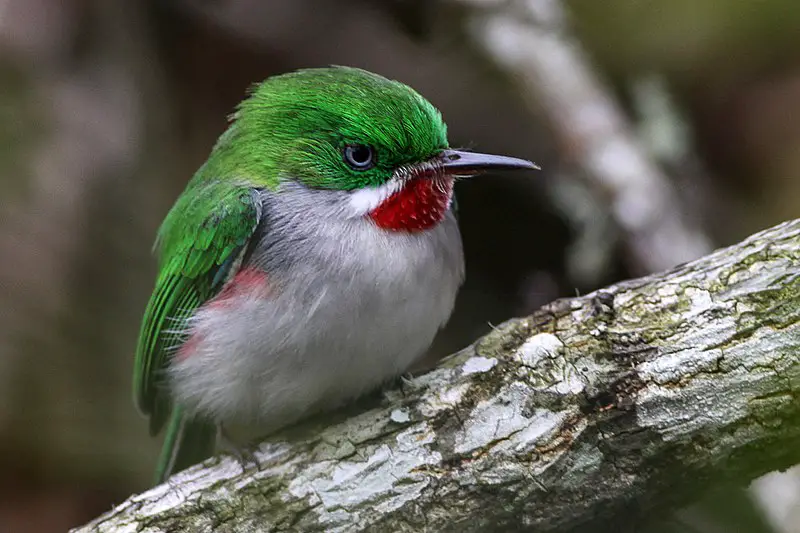
The Narrow-billed tody is a species of bird found only on the Caribbean island Hispaniola, shared by the Dominican Republic and Haiti. It has a distinctive narrow bill, hence its name.
This small colorful bird measures up to 4 inches in length and features an olive green back with a yellowish head, throat, and chest as well as white underparts. The male also sports two black stripes above each eye while females have one stripe per eye.
These birds feed mainly on insects that they capture from foliage or catch out of midair using their wings for balance during flight maneuvers.
They are usually seen singly or in pairs but rarely form larger flocks like other types of Todidae family members do.
Narrow-billed todies inhabit forests both dry and wet, evergreen shrubs near riversides, and even urban gardens where trees provide plenty food sources such as caterpillars.
Scientific classification:
| Kingdom | Animalia |
| Phylum | Chordata |
| Class | Aves |
| Order | Coraciiformes |
| Family | Todidae |
| Genus | Todus |
| Species | T. angustirostris |
15. Greater Antillean Bullfinch
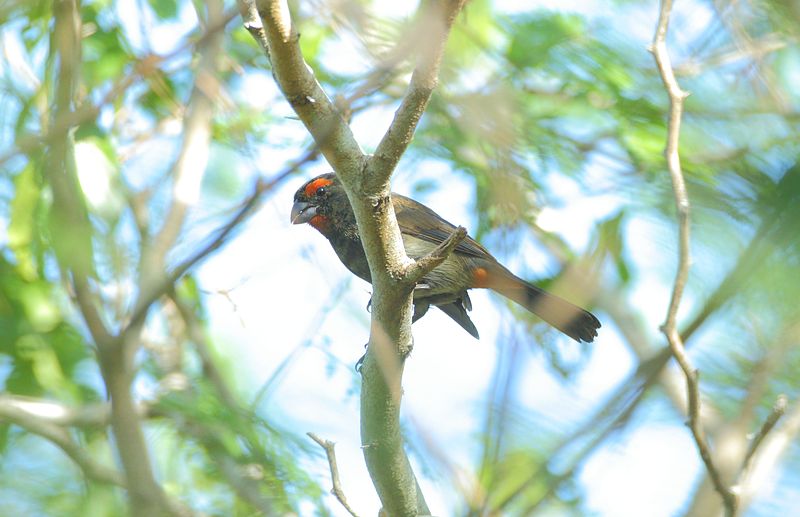
The Greater Antillean Bullfinch is a species of bird in the Thraupidae family. It can be found across many places, like the Bahamas, Hispaniola (Dominican Republic and Haiti), Jamaica, and Turks & Caicos Islands.
This beautiful bird prefers to inhabit subtropical or tropical dry forests as well as moist lowland/montane forests.
Its main features are its bright yellow bill with pink gape flange, and olive green upperparts while underparts have a grey tinge on them along with some white markings near the breast area.
All these characteristics help it stand out from other birds living in similar habitats.
Scientific classification:
| Kingdom | Animalia |
| Phylum | Chordata |
| Class | Aves |
| Order | Passeriformes |
| Family | Thraupidae |
| Genus | Melopyrrha |
| Species | M. violacea |
Also Featured In: Common Birds of Turks and Caicos Islands,
16. La Selle Thrush
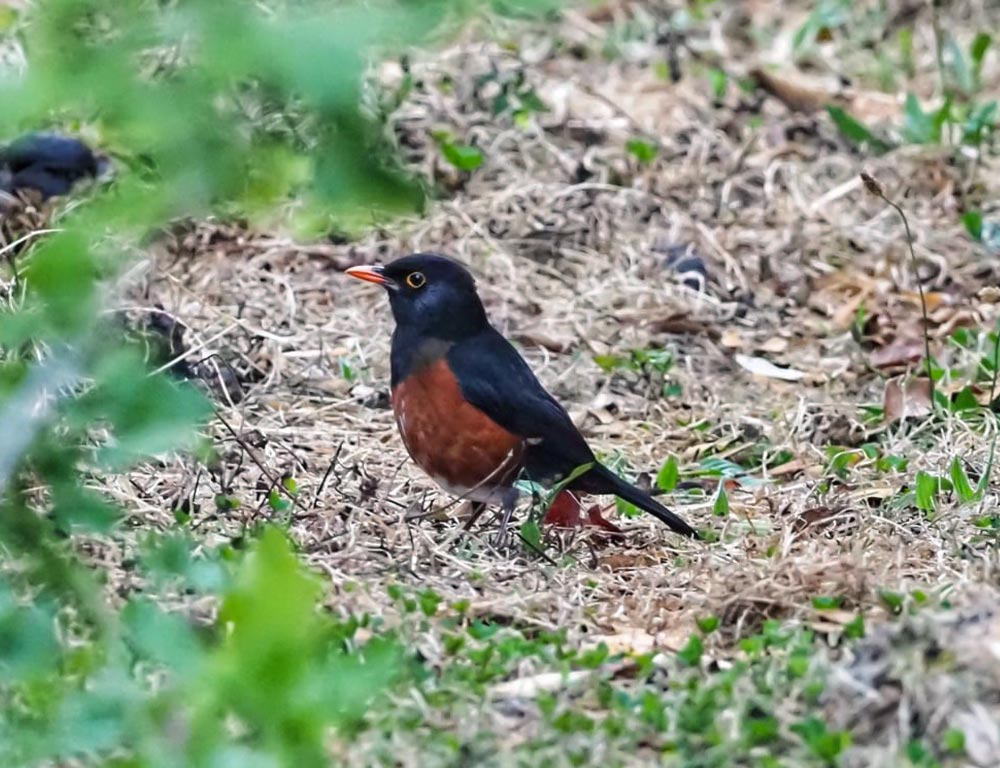
The La Selle thrush is an endemic bird species found in Hispaniola, a Caribbean island shared by the Dominican Republic and Haiti.
It is a skulker of broadleaf and pine forests located around 1300m elevation where it has a limited population which continues to decline due to habitat destruction.
Its name comes from Pic la Selle, Haiti where its relict population lives.
The La Selle Thrush is identified as having rusty-brown upperparts and white underparts with dark spots along the sides of its neck area, making it easy to differentiate from other birds within its range.
Unfortunately because of human activities such as deforestation this beautiful creature’s future remains uncertain but conservation efforts are being made for them in both countries they inhabit so that we can continue admiring them for years to come.
Scientific classification:
| Kingdom | Animalia |
| Phylum | Chordata |
| Class | Aves |
| Order | Passeriformes |
| Family | Turdidae |
| Genus | Turdus |
| Species | T. swalesi |
17. White-Necked Crow
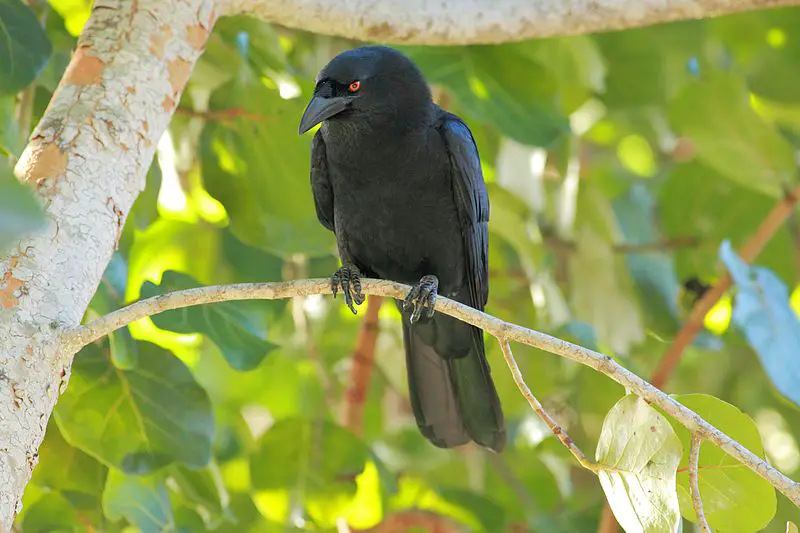
The White-necked Crow is the largest of all Caribbean corvids. It is native to Hispaniola, an island split between Haiti and Dominican Republic.
Unfortunately, this species has been wiped out from Puerto Rico due to relentless human activities such as forest clearance and hunting.
Two other crow species that are closely related to it include the Cuban Crow (C. nasicus) and Jamaican Crow (C. jamaicensis). This bird stands at a height of approximately 50 cm with its wingspan reaching up to 110cm in length.
Its plumage is composed mainly of black feathers although its neck appears white on closer inspection; hence giving it its name -White-Necked Crow.
Despite being so large they aren’t considered a threat but make excellent scavengers keeping their environment clean by feeding off dead animals or waste products left behind by humans.
Scientific classification:
| Kingdom | Animalia |
| Phylum | Chordata |
| Class | Aves |
| Order | Passeriformes |
| Family | Corvidae |
| Genus | Corvus |
| Species | C. leucognaphalus |
18. Hispaniolan Pewee
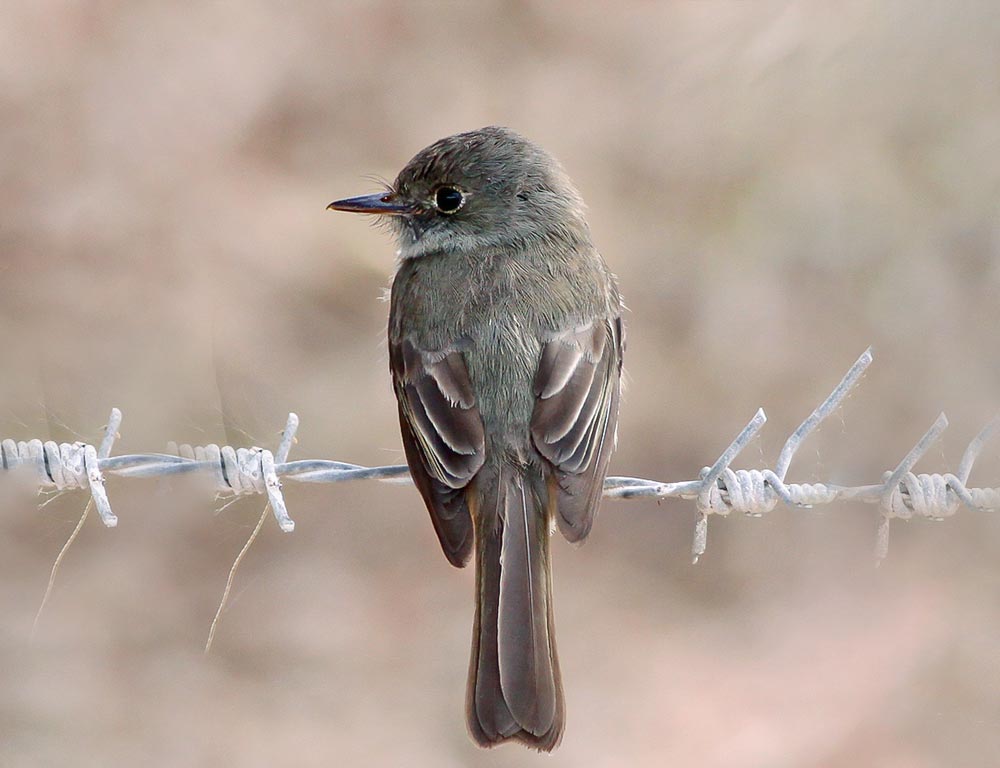
The Hispaniolan pewee is a species of flycatcher found exclusively on the Caribbean island of Hispaniola. It has greyish-brown upperparts and whitish underparts with yellow wing bars, making it easily identifiable in its native habitat.
Its call consists of loud squeaks and high whistles which can often be heard during daytime hours.
As an endemic bird to this island, it plays an important role in maintaining the ecological balance by controlling insects such as mosquitoes and beetles that could damage crops or cause discomfort for humans nearby.
The main threats to their populations are deforestation due to agricultural expansion into natural habitats, climate change, loss of food sources from insecticides used around farms, and competition from other non-native birds entering their range.
Conservation efforts must focus on protecting remaining forests while also promoting sustainable agriculture practices so both people and wildlife may continue coexisting harmoniously together within these tropical landscapes.
Scientific classification:
| Kingdom | Animalia |
| Phylum | Chordata |
| Class | Aves |
| Order | Passeriformes |
| Family | Tyrannidae |
| Genus | Contopus |
| Species | C. hispaniolensis |
19. Flat-Billed Vireo
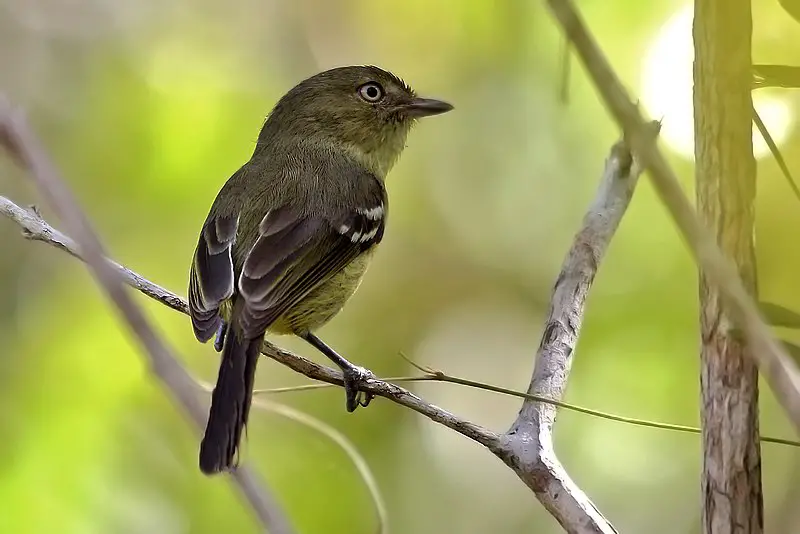
The Flat-billed vireo is an amazing bird found only on the Caribbean island of Hispaniola, split between Haiti and the Dominican Republic.
This species belongs to the Vireonidae family and it inhabits subtropical or tropical dry forests that provide a perfect habitat for them.
The flat-billed vireo has olive upper parts with darker wings, white underparts as well as two whitish wing bars along its body.
It also has a large black eye patch in front of its eyes which are yellowish, giving it an attractive look.
Additionally, this beautiful small bird can be identified by its unique ‘flat bill’ which is slightly curved in a downward direction.
Although threatened due to deforestation caused by human activities such as logging and agricultural development; these birds continue to make their home on Hispaniola Island where they remain safe from predators thanks to their camouflaging colors.
Scientific classification:
| Kingdom | Animalia |
| Phylum | Chordata |
| Class | Aves |
| Order | Passeriformes |
| Family | Vireonidae |
| Genus | Vireo |
| Species | V. nanus |
20. Black-Crowned Tanager
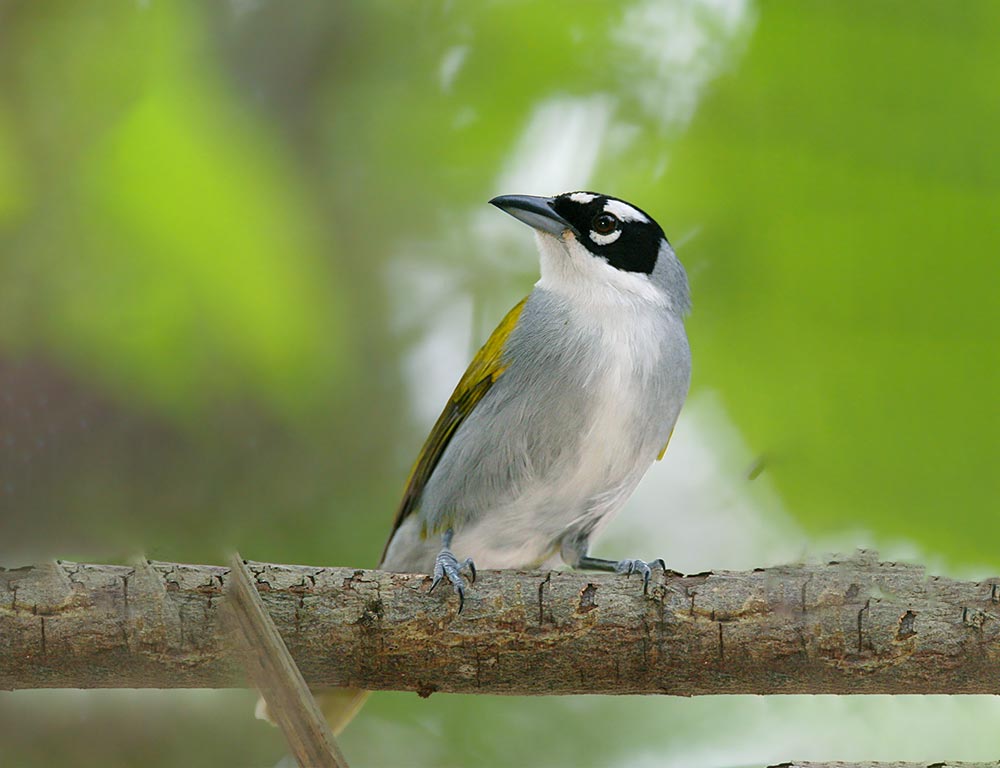
The Black-crowned Tanager (Phaenicophilus palmarum) is a species of bird that belongs to the Phaenicophilidae family. Native to Hispaniola, this tanager was first described by French zoologist Mathurin Brisson in 1760.
This small and compact songbird has an olive upper body with black wings, tail, and head; its belly is yellowish-white in color. It feeds mainly on insects but also eats fruits from trees like palms or figs when available.
During breeding season they can often be seen gathering together around palm fronds while they search for food or sing their distinctive songs full of whistles and trills.
Although not currently threatened, we must monitor their population as deforestation continues throughout Hispaniola so that future generations may continue to enjoy the beauty of these birds.
Scientific classification:
| Kingdom | Animalia |
| Phylum | Chordata |
| Class | Aves |
| Order | Passeriformes |
| Family | Phaenicophilidae |
| Genus | Phaenicophilus |
| Species | P. palmarum |
21. Hispaniolan Woodpecker
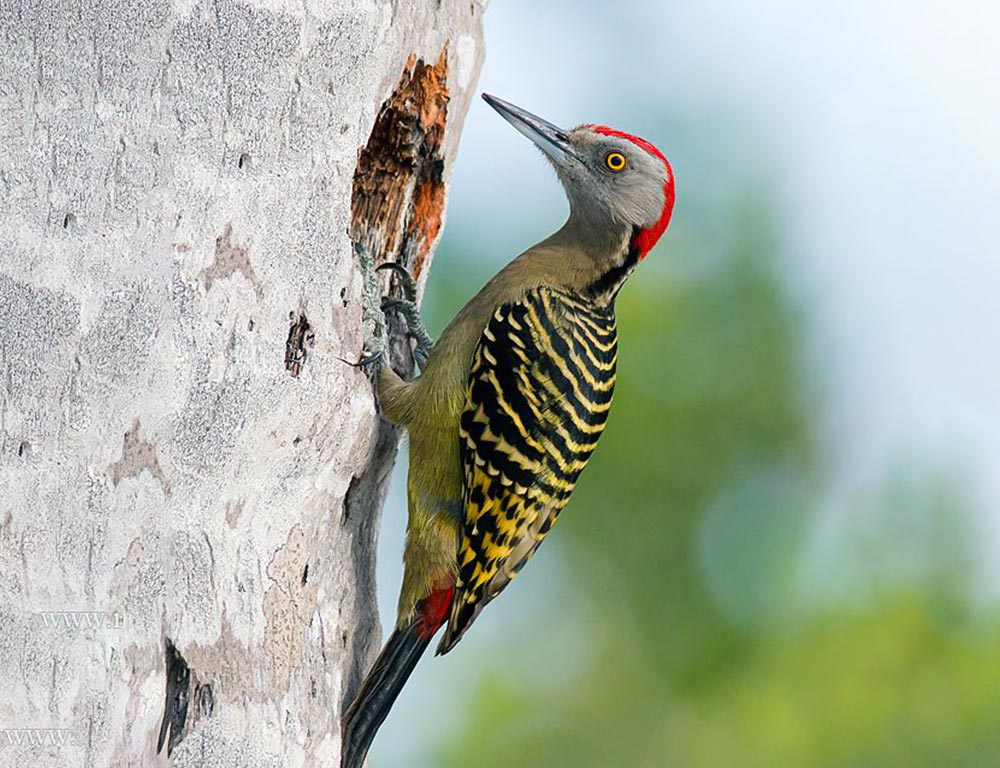
The Hispaniolan woodpecker is a beautiful bird endemic to the Caribbean island of Hispaniola. It has gold and black barred feathers, with males having an added red crown and nape.
The male also has a longer beak than the female, with its upper neck being white in coloration.
This medium-sized woodpecker grows up to 22 – 28 cm long and can often be seen pecking away at tree bark or logs while looking for food such as insects larvae, spiders, lizards, and other small animals.
They mainly inhabit broadleaf forests but can also sometimes be found near plantations or secondary-growth areas.
With their distinctive calls heard throughout these habitats during mating season, it’s easy to spot them amongst any greenery that you may come across on this lovely island.
Scientific classification:
| Kingdom | Animalia |
| Phylum | Chordata |
| Class | Aves |
| Order | Piciformes |
| Family | Picidae |
| Genus | Melanerpes |
| Species | M. striatus |
Also Featured In: Caribbean Birds,
22. Antillean Euphonia
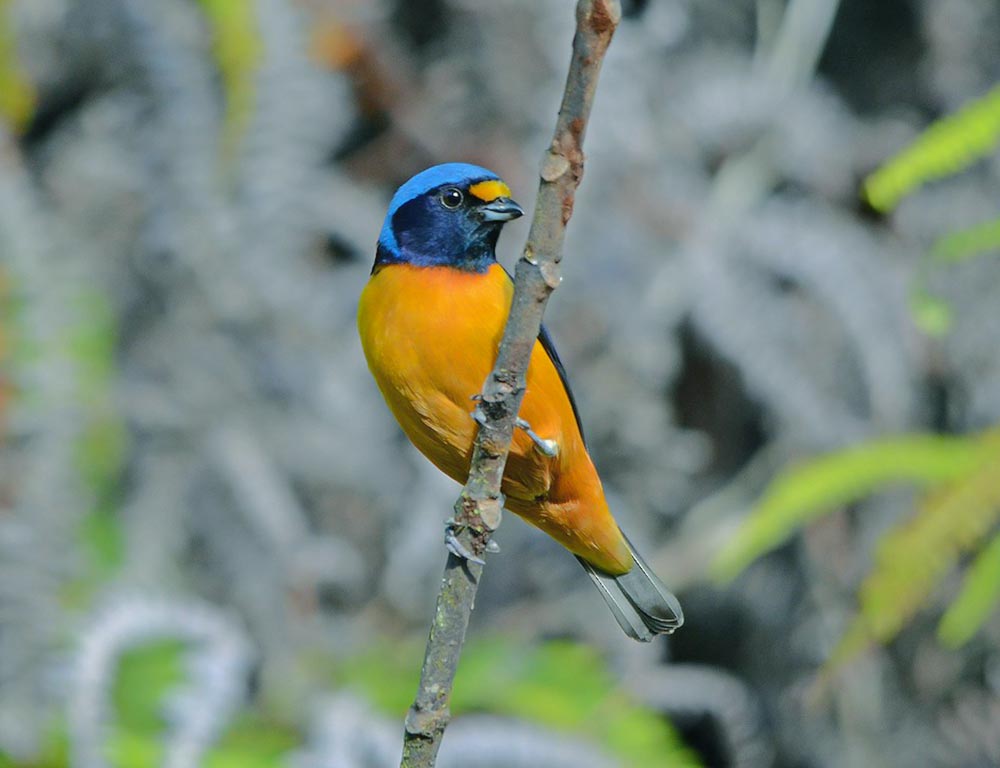
The Antillean Euphonia is a colorful and beautiful bird species found across the Lesser Antilles, Hispaniola (Dominican Republic and Haiti), and Puerto Rico.
It belongs to the Fringillidae family of finches. This small songbird has strong yellow feathers on its head with blue-green upperparts while they have bright orange breasts and bellies.
Their wings are blackish with white tips, giving them an attractive look when flying in flocks through woodlands or forest edges.
They inhabit subtropical or tropical dry forests as well as moist lowland forests including degraded former ones too.
The populations of this species are declining due to deforestation but remain common throughout their range of habitats and can be preserved for their long-term future survival.
Scientific classification:
| Kingdom | Animalia |
| Phylum | Chordata |
| Class | Aves |
| Order | Passeriformes |
| Family | Fringillidae |
| Subfamily | Euphoniinae |
| Genus | Chlorophonia |
| Species | C. musica |
Also Featured In: Martinique Island Birds You Should Know, Native Birds Of Guadeloupe Island
23. Palm Crow
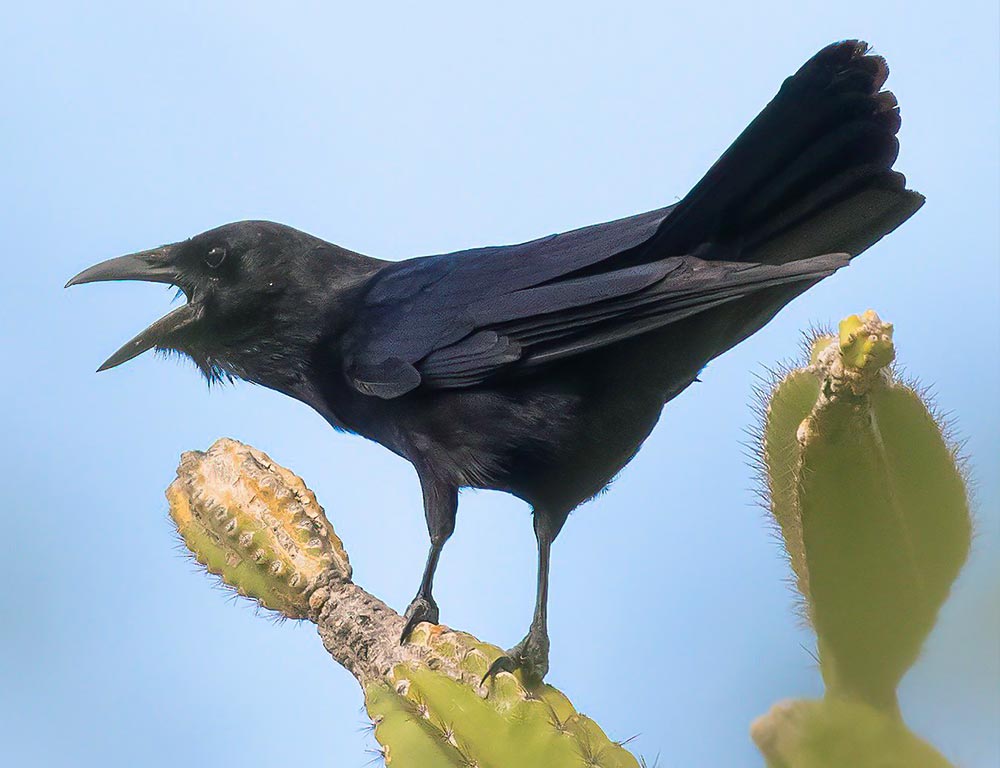
The Palm Crow is a small corvid native to the Caribbean islands of Hispaniola and Cuba. It has two subspecies; one found on each island, with the Cuban variety being slightly smaller in size.
While it used to be very common across both islands, its population has been significantly reduced in recent times.
The Palm crow is known for its distinctive black plumage, which contrasts sharply against its white belly feathers – giving them an almost two-tone appearance when viewed from certain angles.
This species also boasts long legs that are well suited for picking through dense vegetation or wading into shallow water looking for food sources like insects and other invertebrates as well as some fruits and seeds.
Its loud call can often be heard echoing throughout their range making this bird quite easy to identify even if you don’t get a chance to see it up close.
Scientific classification:
| Kingdom | Animalia |
| Phylum | Chordata |
| Class | Aves |
| Order | Passeriformes |
| Family | Corvidae |
| Genus | Corvus |
| Species | C. palmarum |
24. Pine Warbler
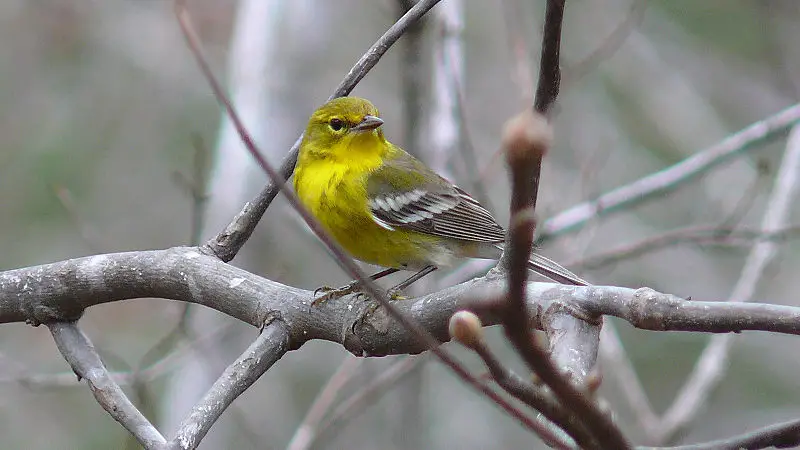
The Pine Warbler is a small bird from the New World Warbler family, with an olive-brown upperparts and white belly.
Its distinguishing features include two white wing bars, dark legs, thin pointed bills, and yellowish ‘spectacles’ around its eyes.
Adult males have bright yellow throats and breasts on top of their olive upper parts; females and immatures are less vibrant in color but retain similar characteristics.
These birds can be found near pine forests throughout North America during the summer months before migrating to warmer climates for winter.
They feed mainly on insects such as caterpillars, spiders, and flies while also consuming fruits like blueberries when food becomes scarce in colder times of the year.
All in all, these tiny songbirds provide us with much beauty through their unique plumage patterns whilst serving important roles within their ecosystems.
Scientific classification:
| Kingdom | Animalia |
| Phylum | Chordata |
| Class | Aves |
| Order | Passeriformes |
| Family | Parulidae |
| Genus | Setophaga |
| Species | S. pinus |
Also Featured In: Most Common Types of Birds Found in Cuba, Most Common Songs Birds that Live around You
25. West Indian Whistling Duck
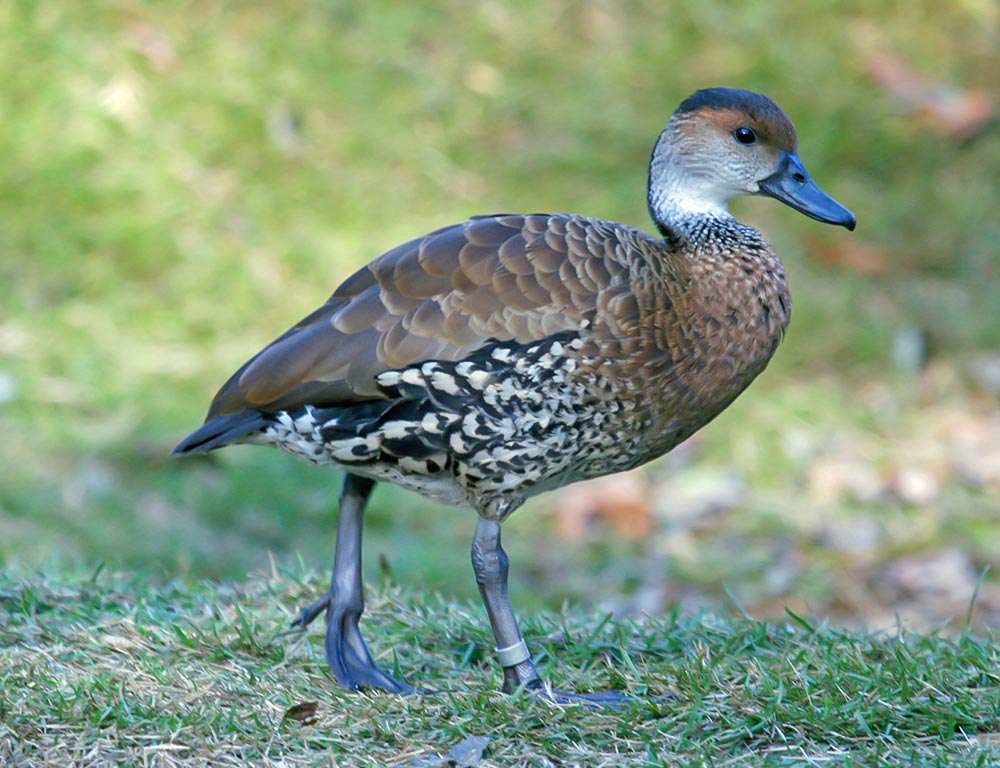
The West Indian whistling duck is a beautiful species of bird native to the Caribbean. This duck has an unmistakable call, as its name implies it can whistle.
It also has black bill and legs with grey-brown feathers that help camouflage it in its environment.
The primary breeding range of this species includes the Bahamas, Cuba, Cayman Islands, Antigua and Barbuda Jamaica, Hispaniola, and Puerto Rico where they live mainly in shallow freshwater wetlands such as ponds or swamps.
Besides their distinctive whistles, these birds can communicate through various other calls including grunts, honks, and quacks.
They feed on aquatic plants but may occasionally eat small invertebrates like insects too.
Despite being hunted for food by humans these ducks remain widespread throughout their habitats due to successful conservation efforts put into place over recent years making them a symbol of hope for many wildlife enthusiasts around the world today.
Scientific classification:
| Kingdom | Animalia |
| Phylum | Chordata |
| Class | Aves |
| Order | Anseriformes |
| Family | Anatidae |
| Genus | Dendrocygna |
| Species | D. arborea |
Also Featured In: Native Birds Of Middle Caicos, Common Birds Found near North Caicos
26. Broad-billed Tody
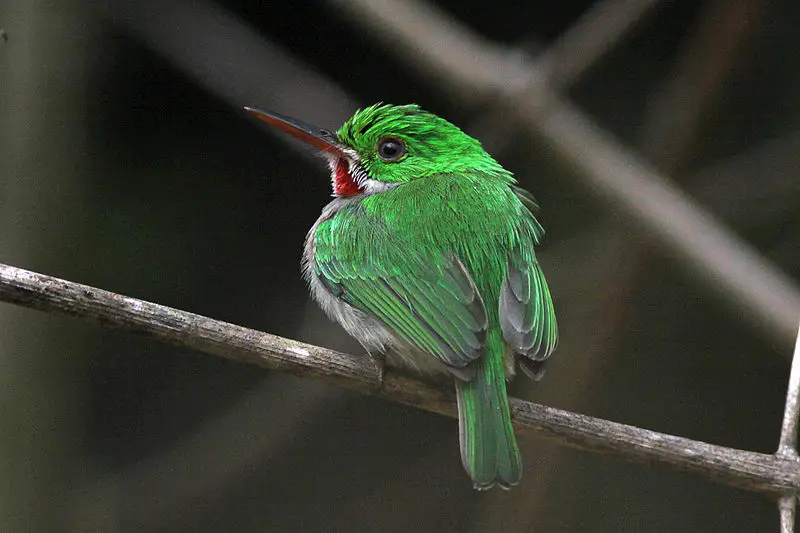
The Broad-billed Tody is a small, brightly colored bird native to Hispaniola. It has green feathers with pink flanks and red throats, making it quite the sight.
These birds prefer drier habitats such as low-lying shrubs or open woodland areas rather than wet rainforests.
Insects are their main source of food as they actively hunt for them in vegetation close to ground level.
Their conservation status is currently Least Concern due to its wide range and adaptability.
However, ongoing habitat loss through deforestation could put this species at risk if not addressed soon enough by the local government authorities.
Scientific classification:
| Kingdom | Animalia |
| Phylum | Chordata |
| Class | Aves |
| Order | Coraciiformes |
| Family | Todidae |
| Genus | Todus |
| Species | T. subulatus |
Also Featured In: Dominican Republic birds,
27. Hispaniolan Emerald
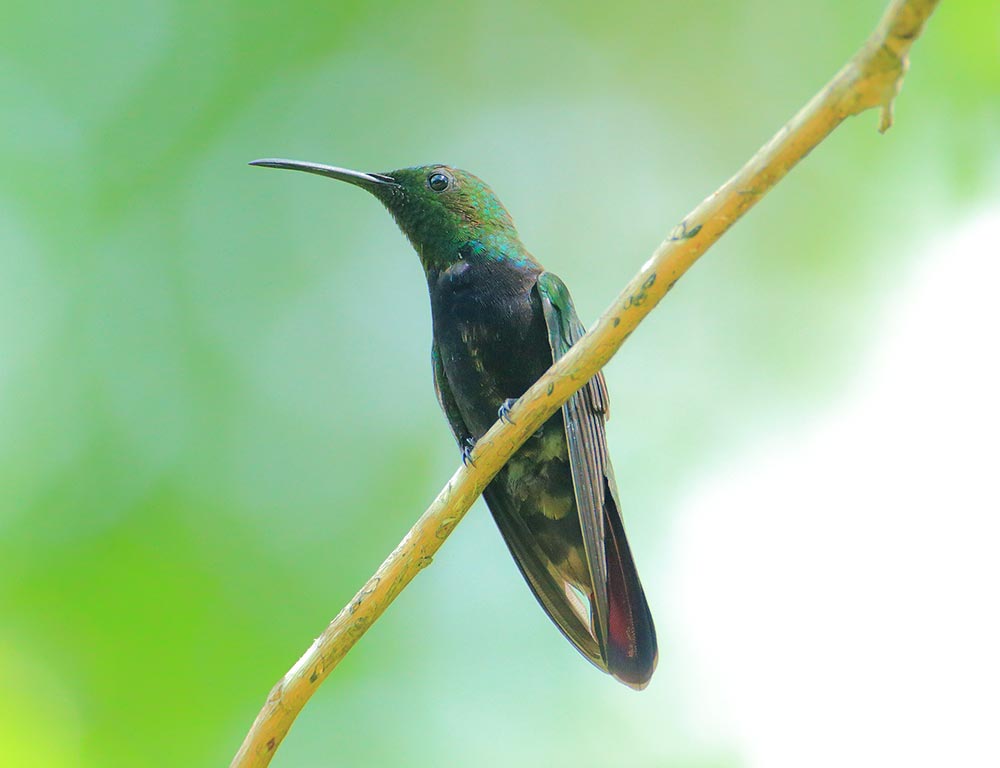
The Hispaniolan emerald is a beautiful species of hummingbird that can only be found in the Caribbean island of Hispaniola.
This stunning bird, which belongs to the Trochilinae subfamily and “emeralds” tribe, features striking green feathers with vibrant orange highlights on its wings and tail.
It was formerly placed within the genus Chlorostilbon but has since been reclassified due to new molecular studies published in 2014 and 2017.
Sadly, this magnificent creature is currently endangered as its native habitat continues to shrink from human development activities such as logging and mining.
Conservation efforts are needed now more than ever if we hope for future generations to enjoy these amazing creatures.
Scientific classification:
| Kingdom | Animalia |
| Phylum | Chordata |
| Class | Aves |
| Order | Apodiformes |
| Family | Trochilidae |
| Genus | Riccordia |
| Species | R. swainsonii |
28. Hispaniolan Amazon
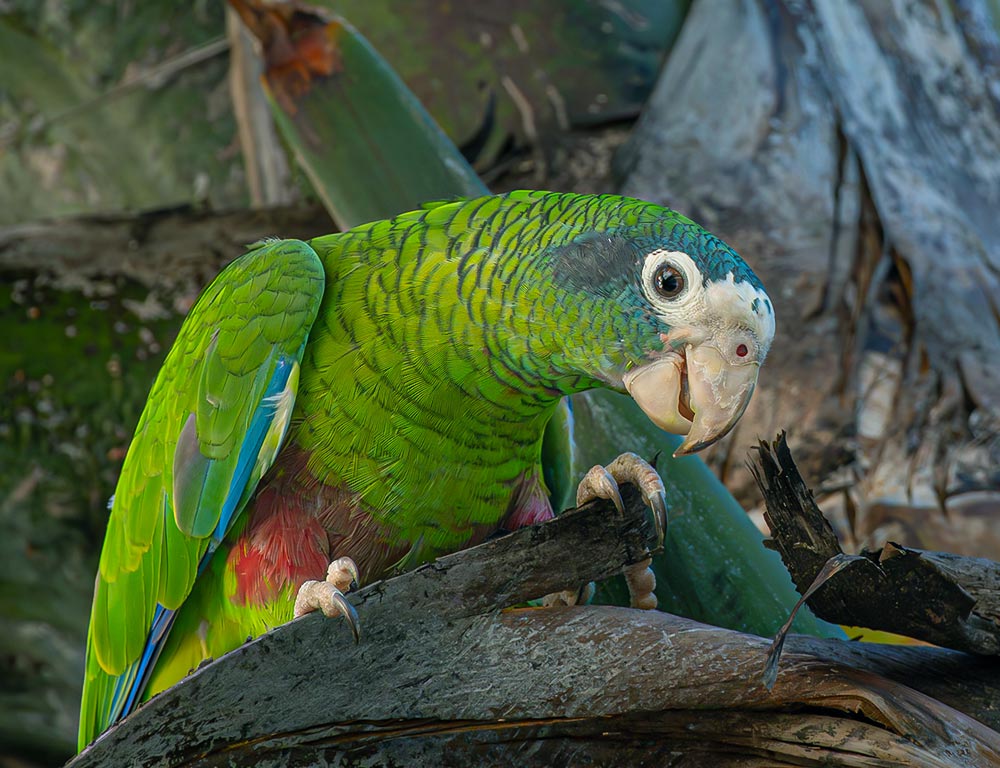
The Hispaniolan amazon is an exotic parrot species that is endemic to the island of Hispaniola. With a unique set of features such as a white forehead, pale beak, white eye-ring, and blue ear patch, this bird stands out from other amazons.
It has been introduced in Puerto Rico too. The cuca (as it’s colloquially called) loves flying around and making its presence felt with loud chirping sounds.
Its red belly makes it even more attractive to look at for avid bird watchers who can spot them easily in their habitats.
All in all, the Hispaniolan Amazon is a beautiful creature well worth admiring.
Scientific classification:
| Kingdom | Animalia |
| Phylum | Chordata |
| Class | Aves |
| Order | Psittaciformes |
| Family | Psittacidae |
| Genus | Amazona |
| Species | A. ventralis |
29. Ridgway’s Hawk
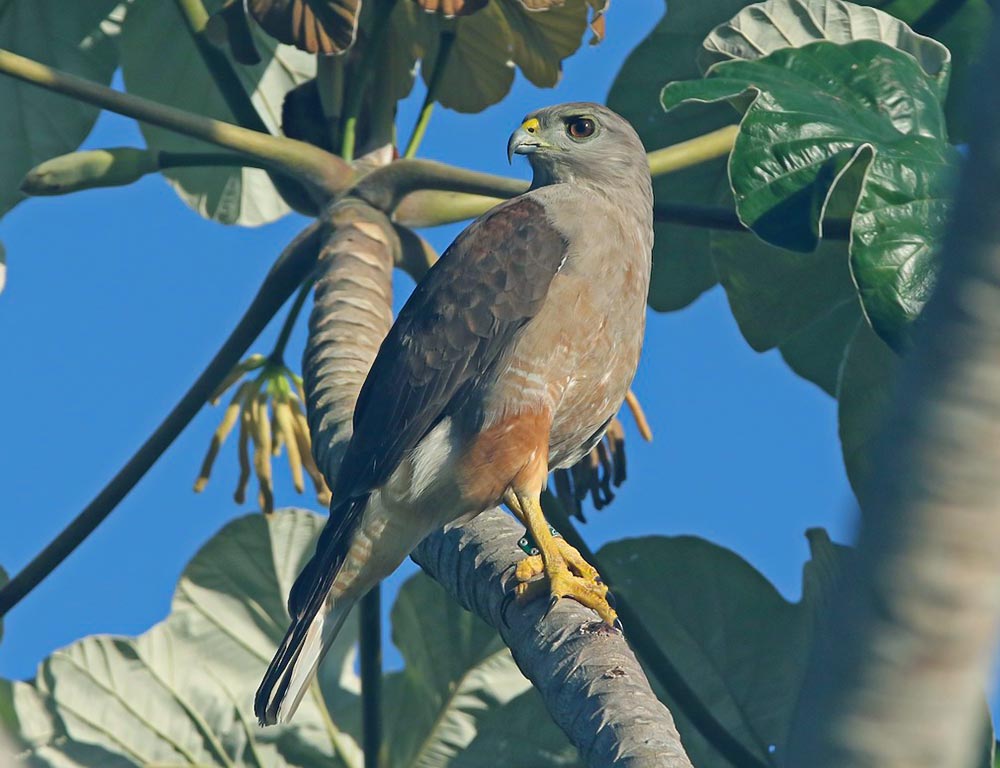
Ridgway’s Hawk is a critically endangered bird of prey native to Hispaniola island in the Caribbean.
This majestic raptor is named after American ornithologist Robert Ridgway and has been threatened by habitat destruction and human persecution in the Dominican Republic.
Thankfully, conservation efforts have enabled its population to start increasing again.
It stands out because of its distinctively dark plumage with light barring on breast, belly, and wings; creamy white throat; bright yellow eyes; curved black beak; long legs covered with reddish feathers at the base; and broad tail banded with pale gray or whitish-yellow stripes.
Its diet consists mostly of small mammals such as rodents but it also feeds on reptiles, amphibians, insects, etc., making it an important part of local ecosystems.
Scientific classification:
| Kingdom | Animalia |
| Phylum | Chordata |
| Class | Aves |
| Order | Accipitriformes |
| Family | Accipitridae |
| Genus | Buteo |
| Species | B. ridgwayi |
30. Hispaniolan Crossbill
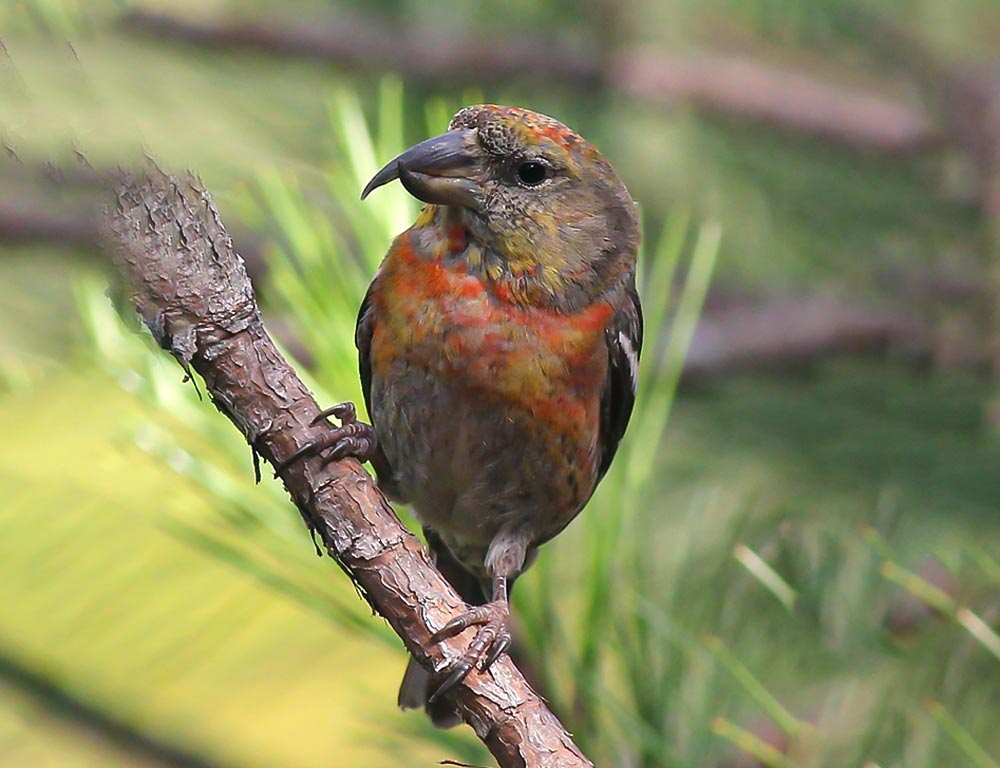
The Hispaniolan crossbill is a unique bird species endemic to the Caribbean island of Hispaniola. It belongs to the Loxia genus and was formerly regarded as conspecific with a two-barred crossbill.
This species has adapted itself well to its environment, making it an important part of this region’s biodiversity.
Its bill shape helps it feed on pine cones, which are abundant throughout Haiti and Dominican Republic forests where they inhabit isolated mountaintops.
The bright orange plumage makes them stand out among other birds while also helping them blend into their surroundings when perched amongst branches or rocks.
They form flocks that travel together seeking food sources such as conifer seeds during winter months giving us another reason why we should protect these birds for future generations.
Scientific classification:
| Kingdom | Animalia |
| Phylum | Chordata |
| Class | Aves |
| Order | Passeriformes |
| Family | Fringillidae |
| Subfamily | Carduelinae |
| Genus | Loxia |
| Species | L. megaplaga |
31. Northern Jacana
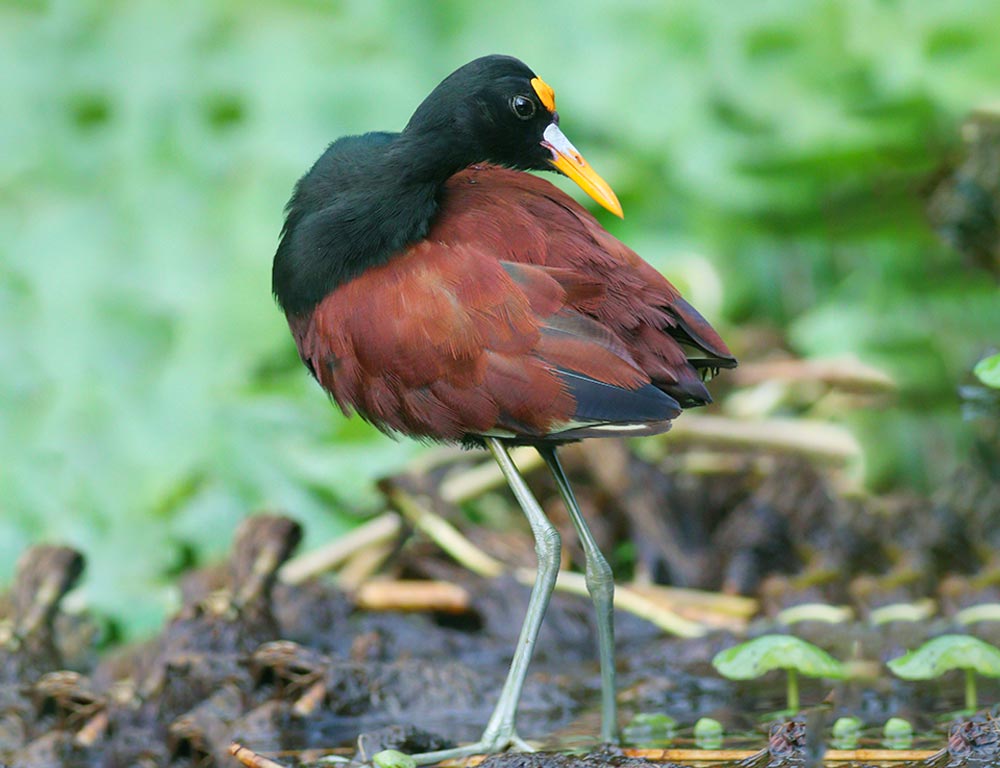
The Northern Jacana is a wading bird native to Mexico, Panama, Cuba, Jamaica, and Hispaniola. It can also be found in Texas as a resident breeder or on rare occasions in Arizona as a vagrant.
This species of wetland birds are easily identified by their immense size and large feet with long toes that help them walk atop floating vegetation while searching for food.
Their upperparts have black feathers streaked with white whilst their underparts display brown plumage marked by yellowish spots near the wingtips.
They feed primarily on insects but will also eat other aquatic invertebrates like crustaceans or mollusks when available.
The female builds an untidy nest made from leaves close to the water so she can quickly escape predators if needed.
Scientific classification:
| Kingdom | Animalia |
| Phylum | Chordata |
| Class | Aves |
| Order | Charadriiformes |
| Family | Jacanidae |
| Genus | Jacana |
| Species | J. spinosa |
Also Featured In: Birds that Live in Jalisco Birds, Most Common Oaxaca Birds
32. Vervain Hummingbird
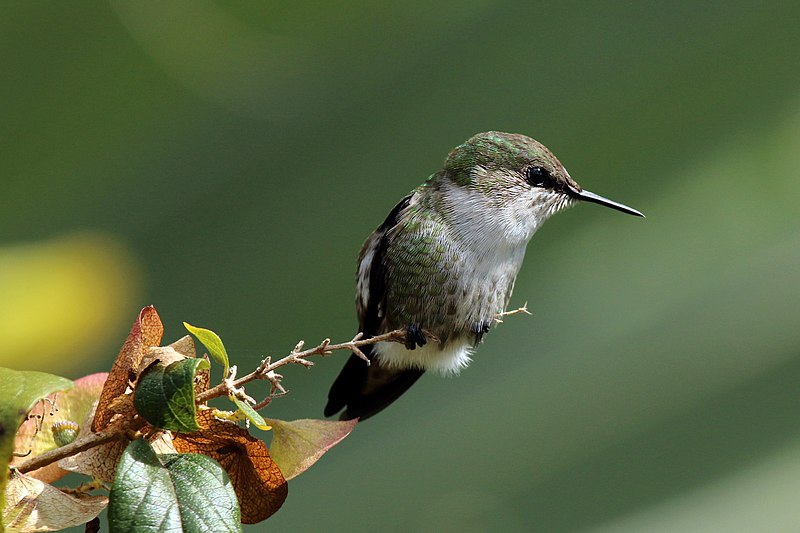
The Vervain Hummingbird is a species of hummingbird belonging to the Mellisugini tribe in the Trochilinae subfamily. It can be found on Hispaniola and Jamaica, where it inhabits humid forests at elevations up to 2200m above sea level.
This tiny bird has an overall length of 3-4 inches with iridescent feathers that range from greenish bronze to bluish-purple depending on the light angle.
Its wings are short and narrow for quick maneuvering through densely vegetated areas, while its long bill allows it to feed nectar efficiently from tubular flowers such as Penstemon or columbine.
These birds also hunt small insects around foliage during their search for food sources year-round, making them important pollinators within their native habitats.
Scientific classification:
| Kingdom | Animalia |
| Phylum | Chordata |
| Class | Aves |
| Order | Apodiformes |
| Family | Trochilidae |
| Genus | Mellisuga |
| Species | M. minima |
33. Olive-throated parakeet
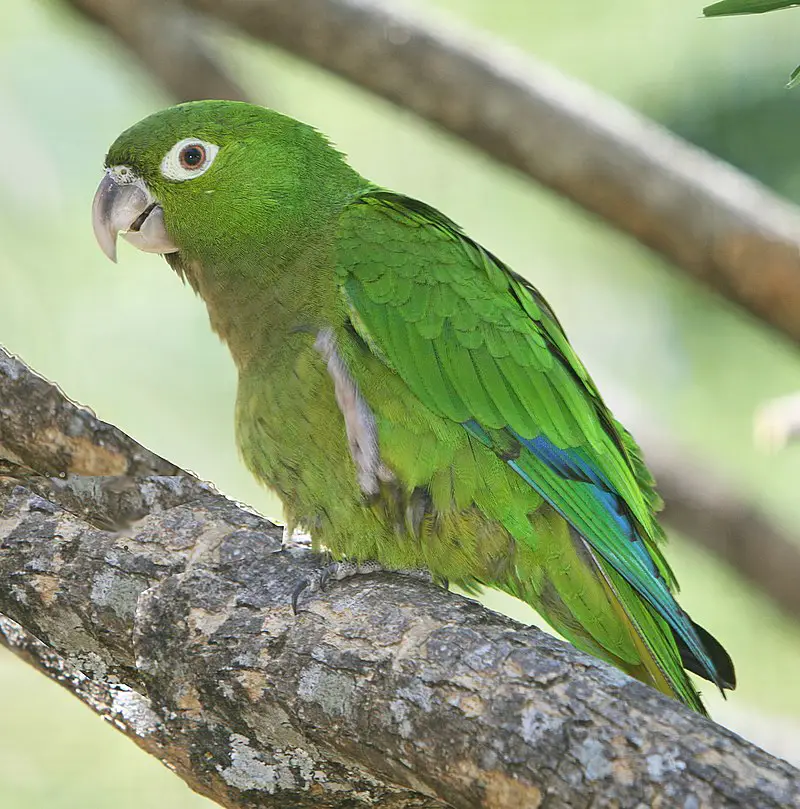
Olive-throated parakeets are native to Jamaica, Mexico, and Central America. They have been introduced to Hispaniola in the Dominican Republic as well.
These birds feature a brown throat with orange eyes in adults and brown eyes in juveniles.
When they take flight their call is distinctive – high-pitched chirps that sound like “wee-cheee”.
Olive-throated parakeets live primarily in forests or woodlands but can also be found around agricultural areas such as farms where there is plenty of food available for them to eat.
The diet of these birds consists mainly of fruits, seeds, nuts, and flowers from plants though they will occasionally feed on insects too.
They form tight bonds with one another which helps protect against predators when living together in flocks and keeps their social structure strong within these groups.
Scientific classification:
| Kingdom | Animalia |
| Phylum | Chordata |
| Class | Aves |
| Order | Psittaciformes |
| Family | Psittacidae |
| Genus | Eupsittula |
| Species | E. nana |
Also Featured In: Jamaica birds,
34. Rufous-Throated Solitaire
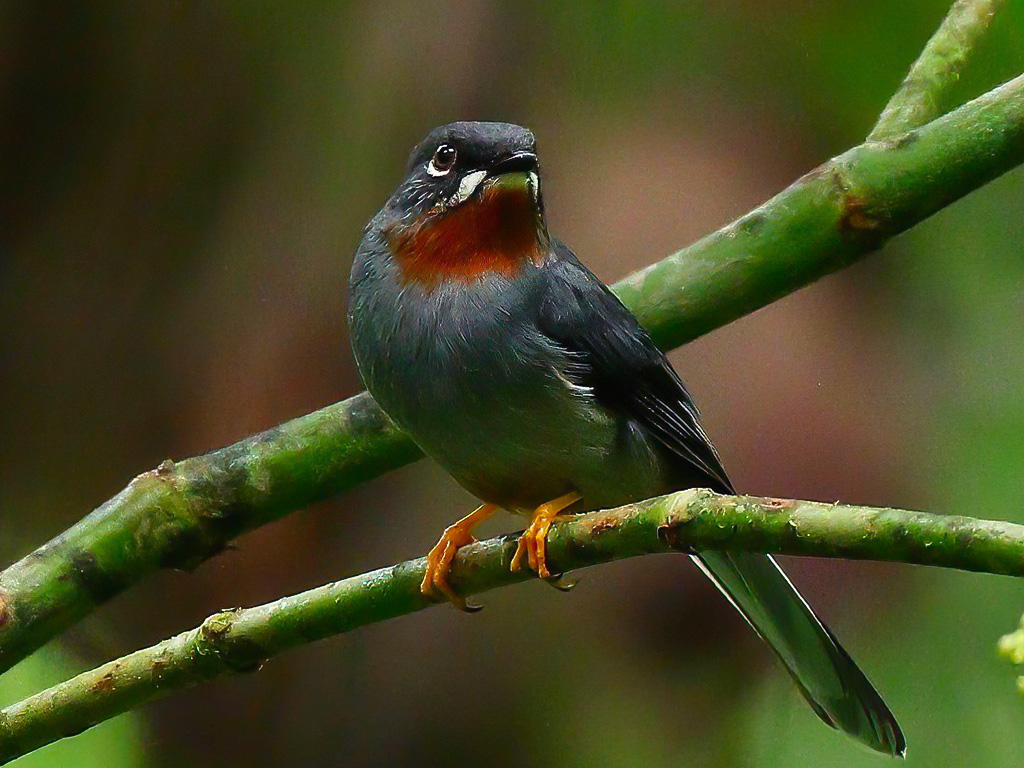
The Rufous-throated Solitaire is a species of bird belonging to the Turdidae family. It can be found in the Dominican Republic, Haiti, Jamaica, Martinique, and other Caribbean Islands with natural habitats including subtropical or tropical moist lowland forests and montane forests.
This beautiful medium-sized songbird has unique characteristics like its greyish brown body coloration combined with an orangey throat that gives it its name; rufous-throated solitaire.
Besides being known by this name they are also nicknamed the ‘siffl’.
Unfortunately due to habitat destruction, their population numbers have declined over recent years but conservation efforts are making some progress towards preserving these animals for future generations.
Scientific classification:
| Kingdom | Animalia |
| Phylum | Chordata |
| Class | Aves |
| Order | Passeriformes |
| Family | Turdidae |
| Genus | Myadestes |
| Species | M. genibarbis |
35. Hispaniolan Nightjar
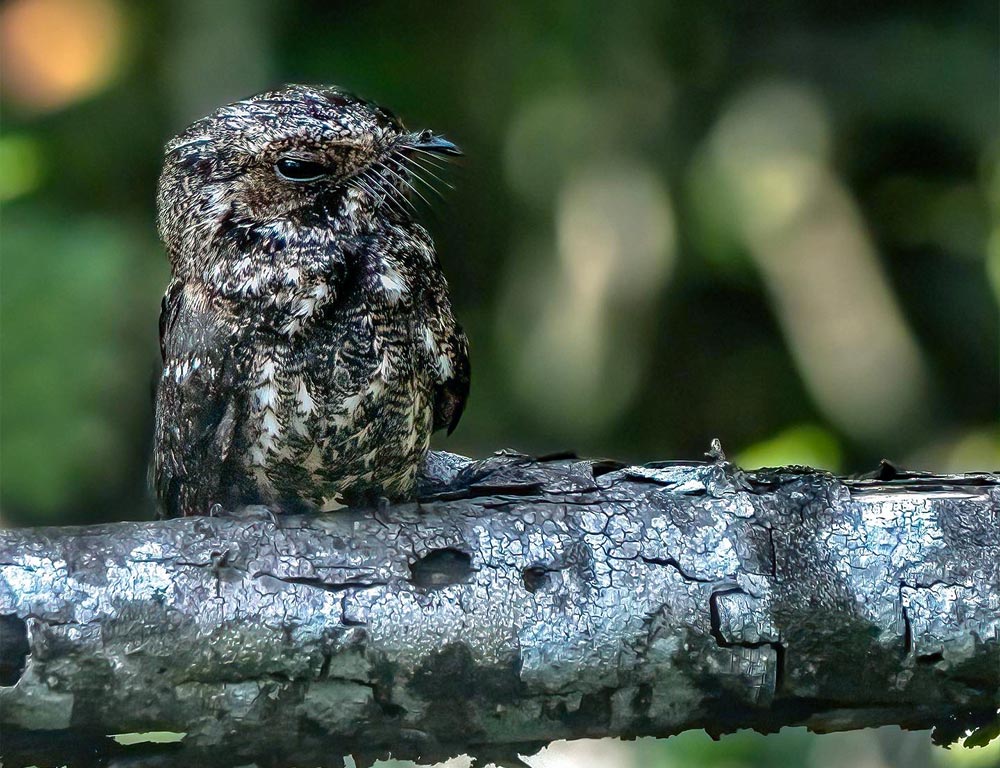
The Hispaniolan nightjar is a nocturnal bird species that is only found on the Caribbean island of Hispaniola. It is endemic to the region and can be found in both the Dominican Republic and Haiti.
The bird was first described as Antrostomus ekmani but was later grouped into the Caprimulgus genus before being restored as its own separate genus. As a nightjar, the Hispaniolan nightjar feeds on insects during the night and spends most of the day roosting on the ground or in trees.
Its distinct call is a loud, repetitive “churr” sound that can be heard throughout its range. Due to its limited range and habitat loss, the Hispaniolan nightjar is considered a vulnerable species by BirdLife International.
Scientific classification:
| Kingdom | Animalia |
| Phylum | Chordata |
| Class | Aves |
| Clade | Strisores |
| Order | Caprimulgiformes |
| Family | Caprimulgidae |
| Genus | Antrostomus |
| Species | A. ekmani |
36. Greater Antillean Elaenia
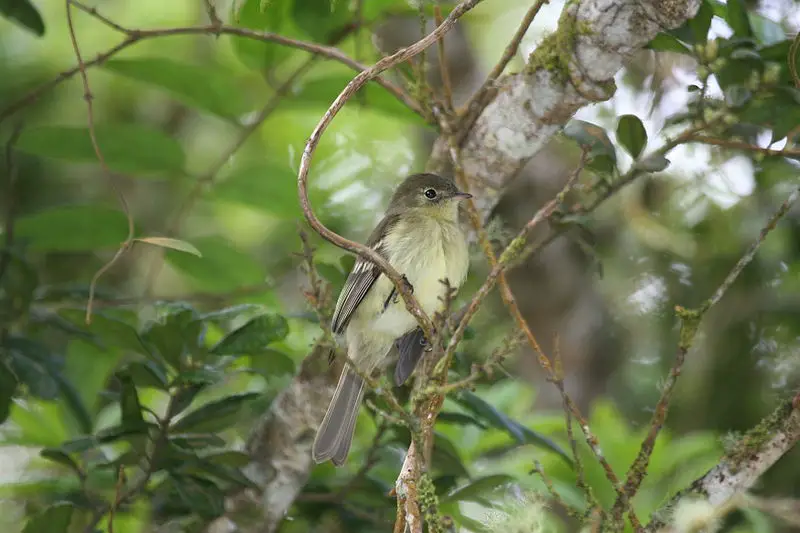
The Greater Antillean elaenia is a bird species in the Tyrannidae family. It inhabits the tropical and subtropical lowland forests of Hispaniola and Jamaica.
This bird has two subspecies, distinguished by their genetic structure and unique vocalizations. Its primary diet consists of insects and fruits. The bird has a unique trait of flicking its tail while perched on a branch.
Greater Antillean elaenias are known for their distinctive calls, and can often be heard calling out to each other in the forest.
They are small birds, typically not exceeding 13 cm in length. The species is not currently considered threatened, but habitat loss due to deforestation is a growing concern.
There is still much to be learned about this stunning bird species and their behavior in the wild.
Scientific classification:
| Kingdom | Animalia |
| Phylum | Chordata |
| Class | Aves |
| Order | Passeriformes |
| Family | Tyrannidae |
| Genus | Elaenia |
| Species | E. fallax |
37. Golden Swallow
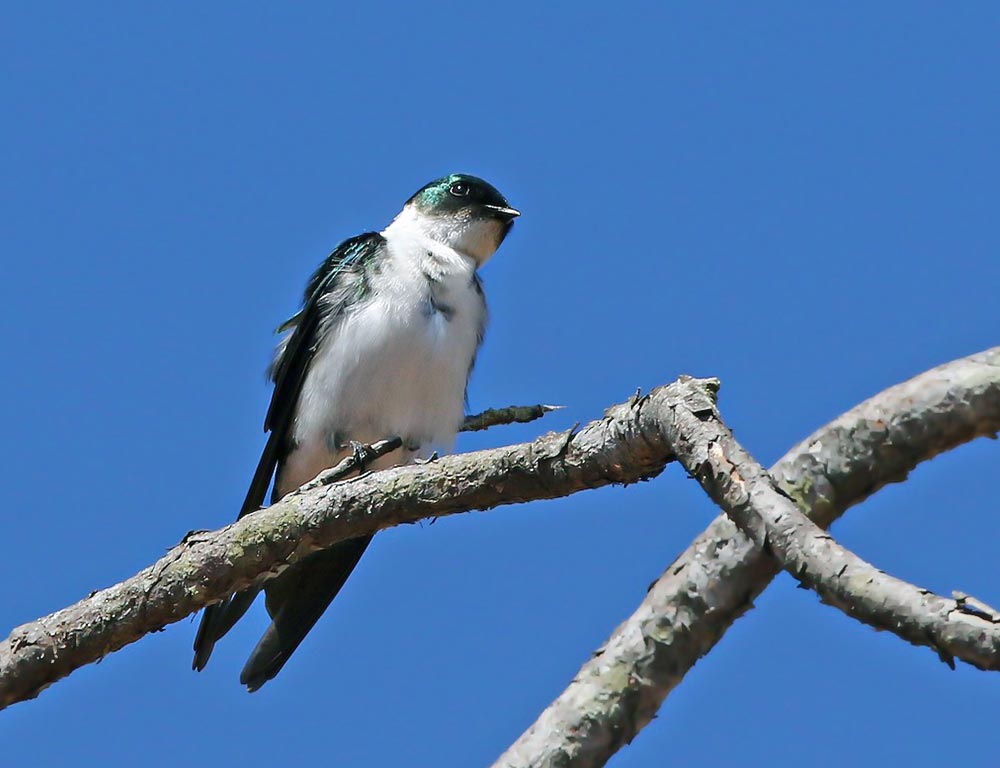
The Golden Swallow is a beautiful bird that can only be found in the Caribbean island of Hispaniola. Sadly, it is no longer native to Jamaica.
It mainly inhabits isolated montane forests that are predominantly made up of the Hispaniolan pine.
This bird is considered to be vulnerable according to the International Union for Conservation of Nature (IUCN). It belongs to the swallow family and is scientifically known as Tachycineta euchrysea.
The Golden Swallow has a unique golden-yellow plumage, making it stand out among other birds in its habitat.
This species is essential in maintaining the ecological balance and diversity of its environment. A lot needs to be done to preserve and protect this species from extinction.
Scientific classification:
| Kingdom | Animalia |
| Phylum | Chordata |
| Class | Aves |
| Order | Passeriformes |
| Family | Hirundinidae |
| Genus | Tachycineta |
| Species | T. euchrysea |
38. Grey-Crowned Tanager
The Grey-crowned tanager, also known as the Grey-crowned palm-tanager, is a bird species found in the Hispaniola island. It belongs to the Phaenicophilidae family of Hispaniolan tanagers.
This near-threatened bird is endemic to the Dominican Republic and Haiti. The Black-crowned tanager is its closest relative, and the two species have been known to hybridize.
The Grey-crowned tanager has a grey crown, as its name suggests, and its body is mostly green.
As a bird species living in a vulnerable status, it is important to study and protect their habitats to ensure their survival.
Scientific classification:
| Kingdom | Animalia |
| Phylum | Chordata |
| Class | Aves |
| Order | Passeriformes |
| Family | Phaenicophilidae |
| Genus | Phaenicophilus |
| Species | P. poliocephalus |
39. Tawny-Shouldered Blackbird
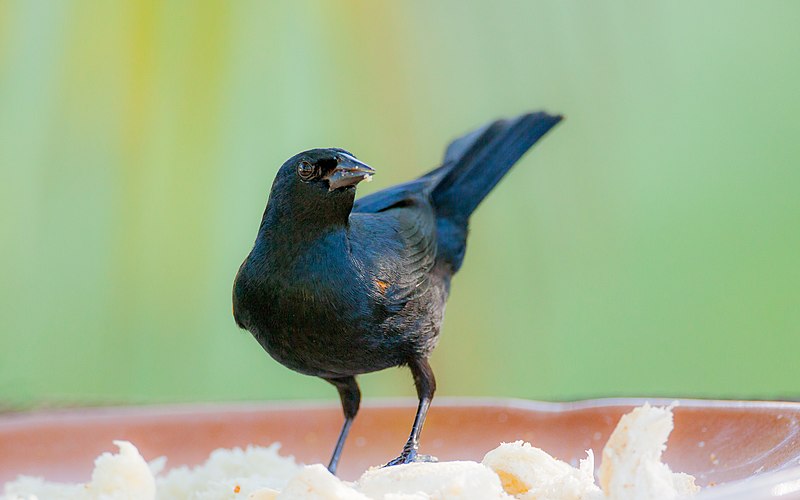
The Tawny-shouldered blackbird, also known as Agelaius Humeralis, is a bird from the Icteridae family, found in Cuba, Hispaniola, and occasionally in the Florida Keys.
This social bird measures 20 centimeters long and is entirely black, except for its distinctive brown-orange patch on its shoulder. This unique feature helps distinguish the bird from other blackbirds.
These birds are known to be highly social, living in small flocks. They are omnivores, feeding on both insects and seeds. Sadly, the Tawny-shouldered blackbird is facing threats such as habitat loss and hunting.
Conservation organizations are working hard to protect this unique species and ensure its survival. Despite its challenges, the Tawny-shouldered blackbird remains a beautiful and significant member of the avian family.
Scientific classification:
| Kingdom | Animalia |
| Phylum | Chordata |
| Class | Aves |
| Order | Passeriformes |
| Family | Icteridae |
| Genus | Agelaius |
| Species | A. humeralis |
40. Stolid Flycatcher
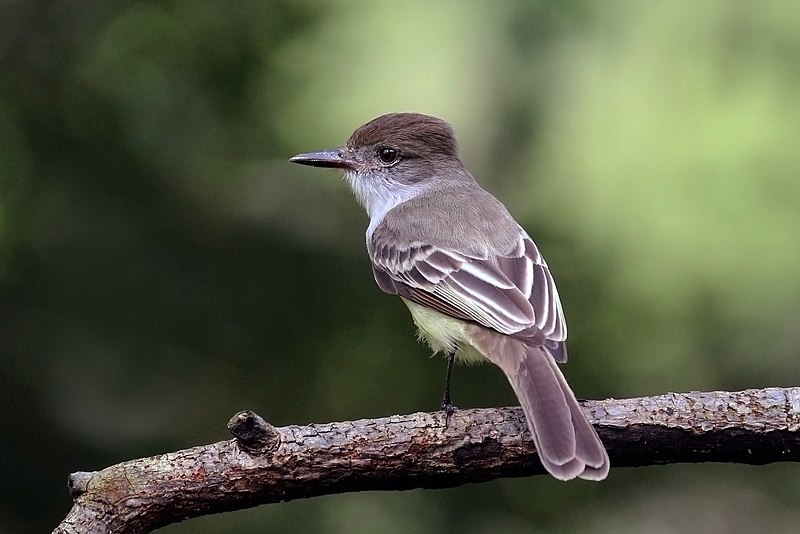
The stolid flycatcher is a bird species that belongs to the Tyrannidae family. This bird is native to Jamaica, Hispaniola, and Haiti. The stolid flycatcher can thrive in subtropical or tropical dry forests, mangrove forests, and degraded former forest landscapes.
These birds are known for their relatively sedentary nature and are not especially active. They possess dull coloring and do not have any distinct markings.
They often perch on branches or in trees while they wait for prey. The stolid flycatcher is not considered a threatened species, but its natural habitats are at risk due to deforestation and human encroachment.
In some areas where forests have been logged or destroyed, the stolid flycatcher is one of the few bird species that remains.
Scientific classification:
| Kingdom | Animalia |
| Phylum | Chordata |
| Class | Aves |
| Order | Passeriformes |
| Family | Tyrannidae |
| Genus | Myiarchus |
| Species | M. stolidus |
41. Phaenicophilidae
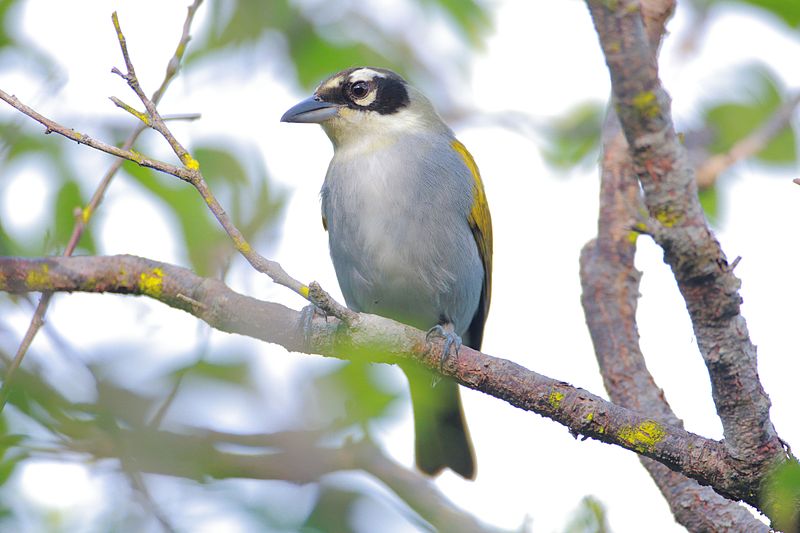
Phaenicophilidae is a unique family of passerine birds that are native to the island of Hispaniola. This family consists of four species belonging to three different genera.
Although they have traditionally been placed in the families Thraupidae and Parulidae, they have since been classified under their own family.
The Phaenicophilidae are known for their striking colors and distinctive features, such as the thick bill of the Phaenicophilus, and their insectivorous diet.
These fascinating birds are considered endemic to Hispaniola, as they are not found anywhere else in the world. Despite their limited distribution, they play a vital role in the ecosystem of Hispaniola, contributing to the local biodiversity of the region.
In conclusion, the Phaenicophilidae family of birds is a unique and important component of the avian fauna of Hispaniola.
Scientific classification:
| Kingdom | Animalia |
| Phylum | Chordata |
| Class | Aves |
| Order | Passeriformes |
| Superfamily | Emberizoidea |
| Family | Phaenicophilidae PL Sclater, 1886 |
To Recap
Hispaniola, the Caribbean island shared by the Dominican Republic and Haiti, truly is a bird lover’s paradise with an impressive array of 41 unique and endemic bird species.
This remarkable diversity, from the colorful Hispaniolan Trogon to the elusive Hispaniolan Amazon parrot, highlights the island’s ecological significance and the need for conservation efforts to protect these rare treasures.
Whether you’re a seasoned birder or simply appreciate the beauty of these avian wonders, Hispaniola offers an enchanting and unforgettable experience for all who visit this remarkable destination.